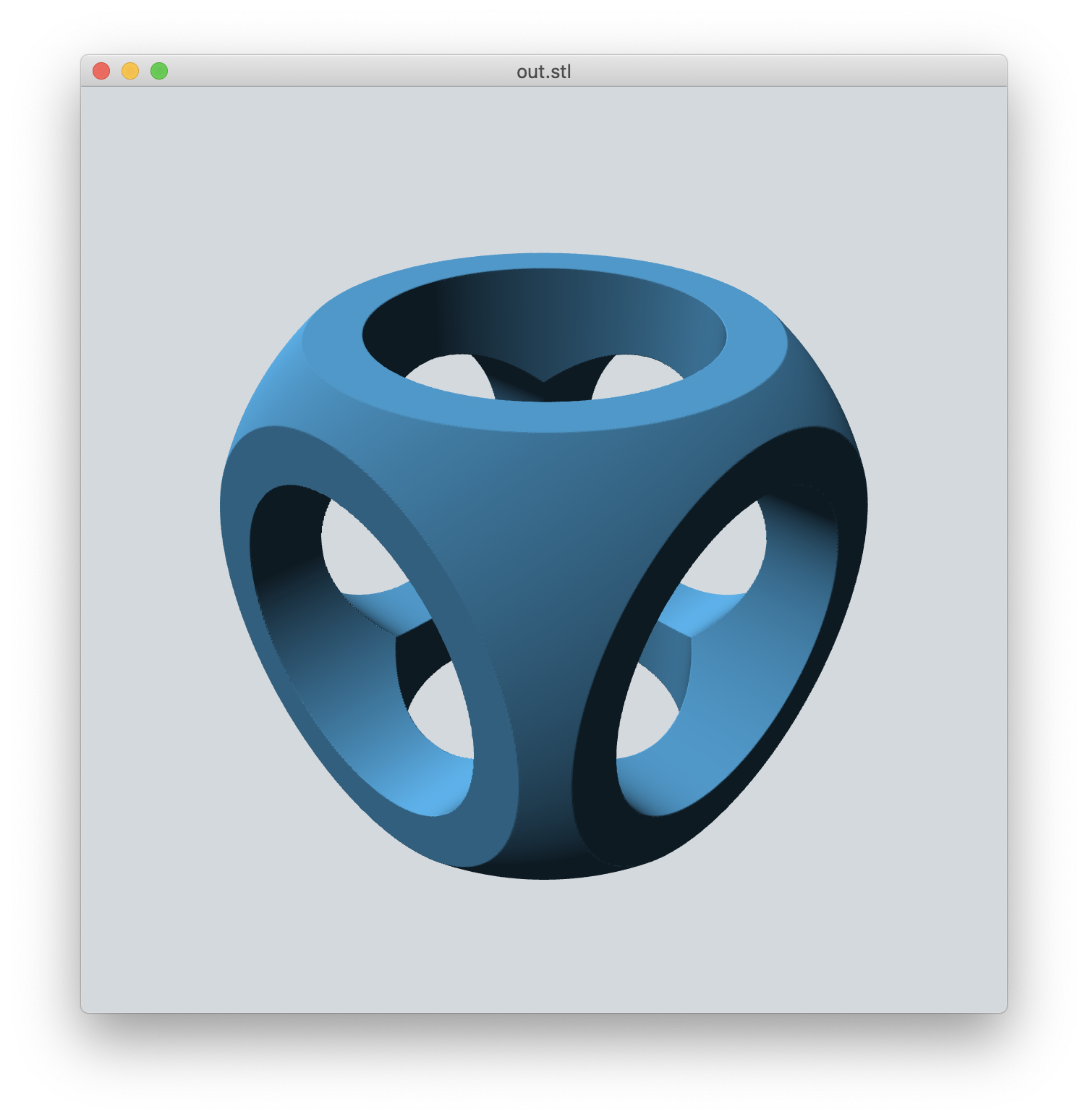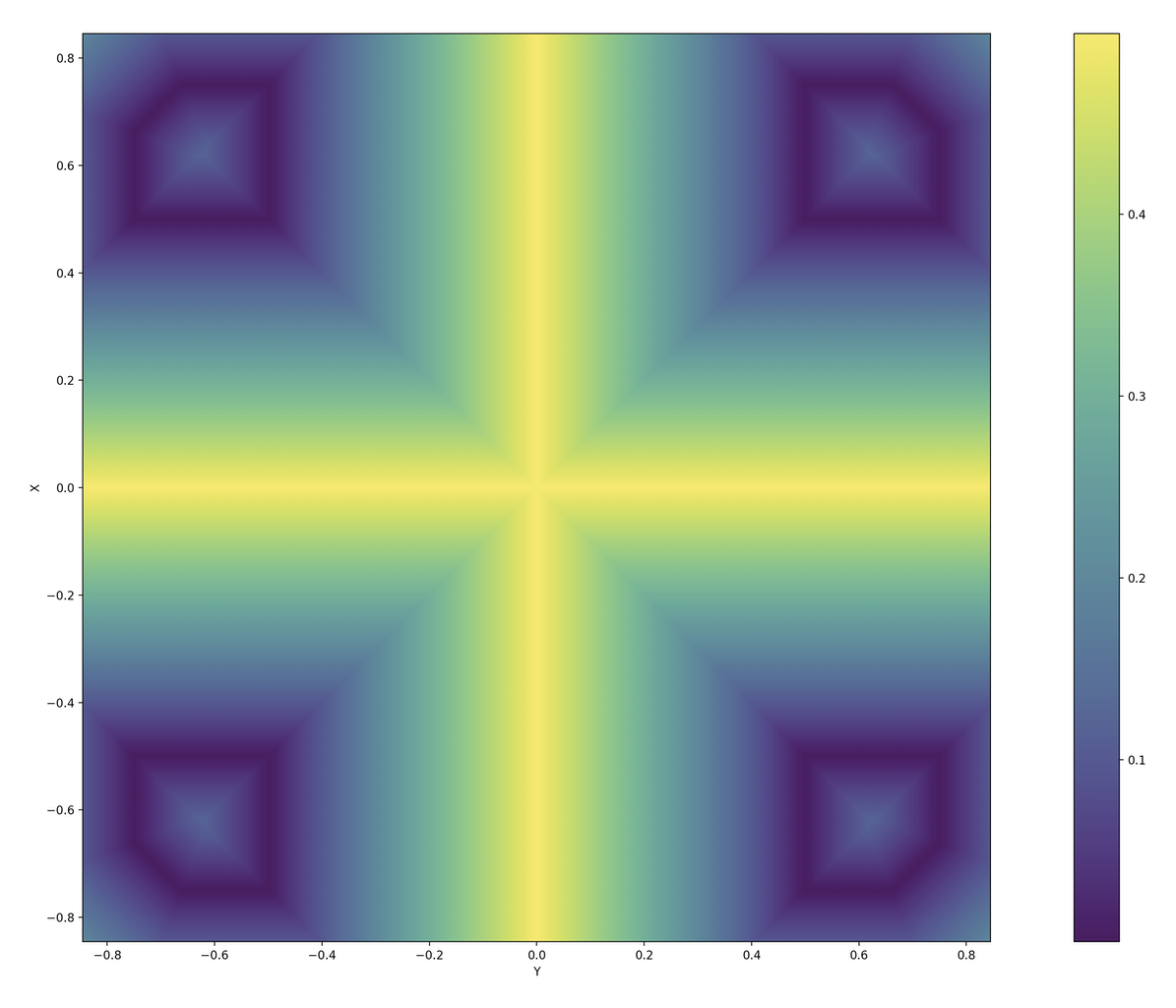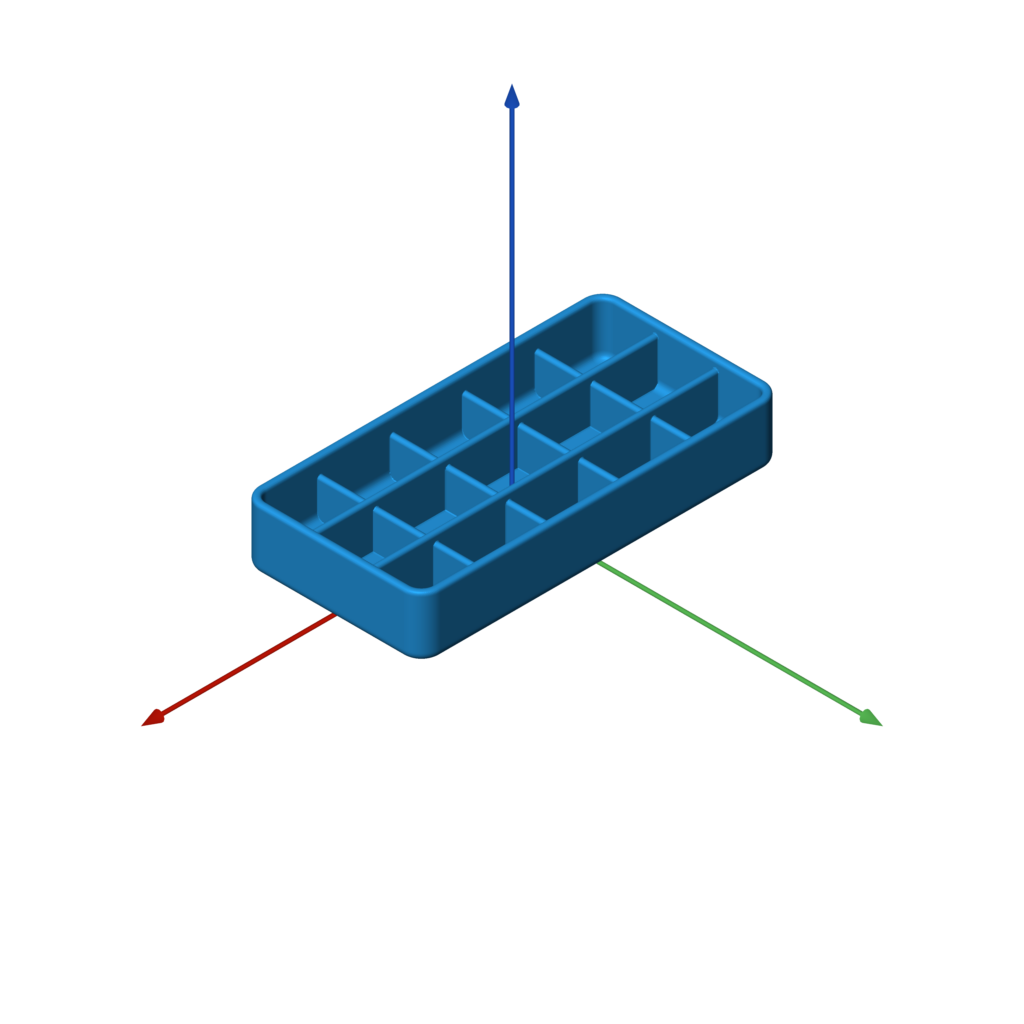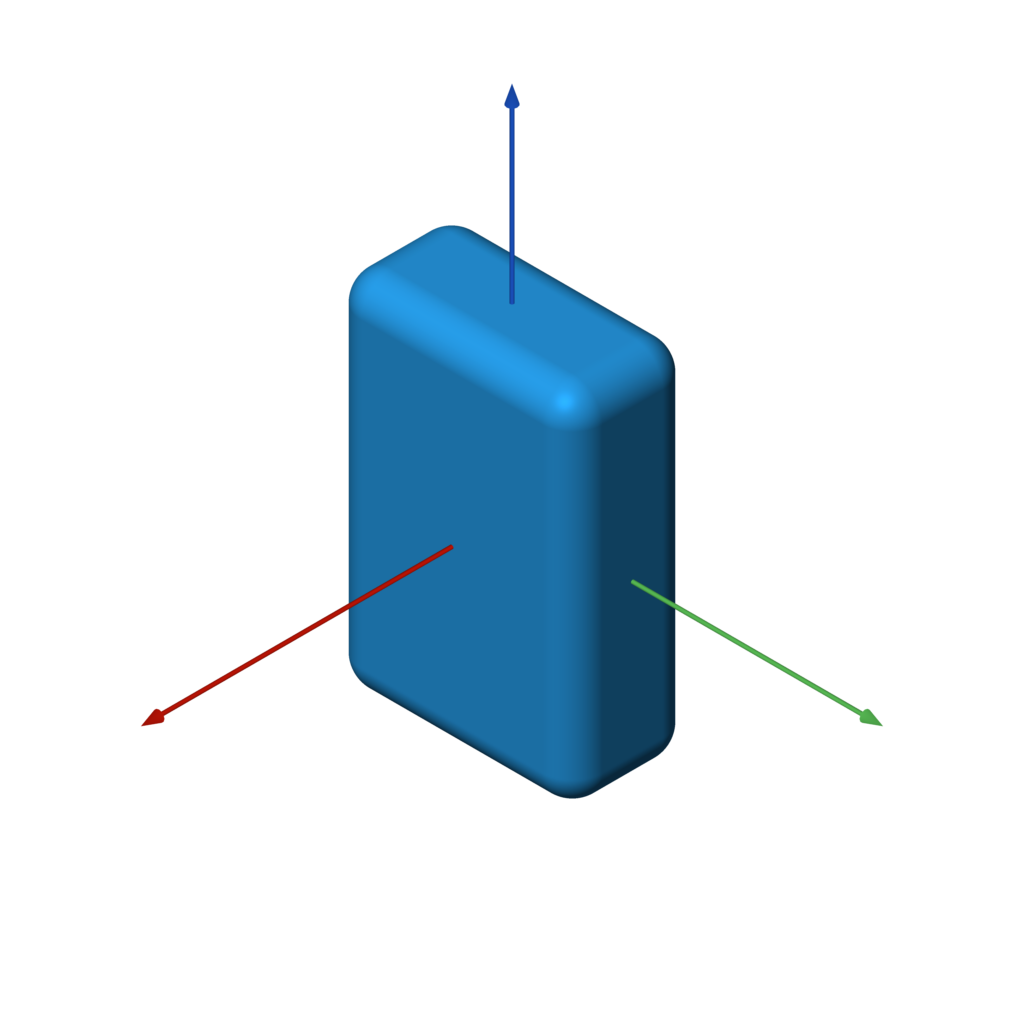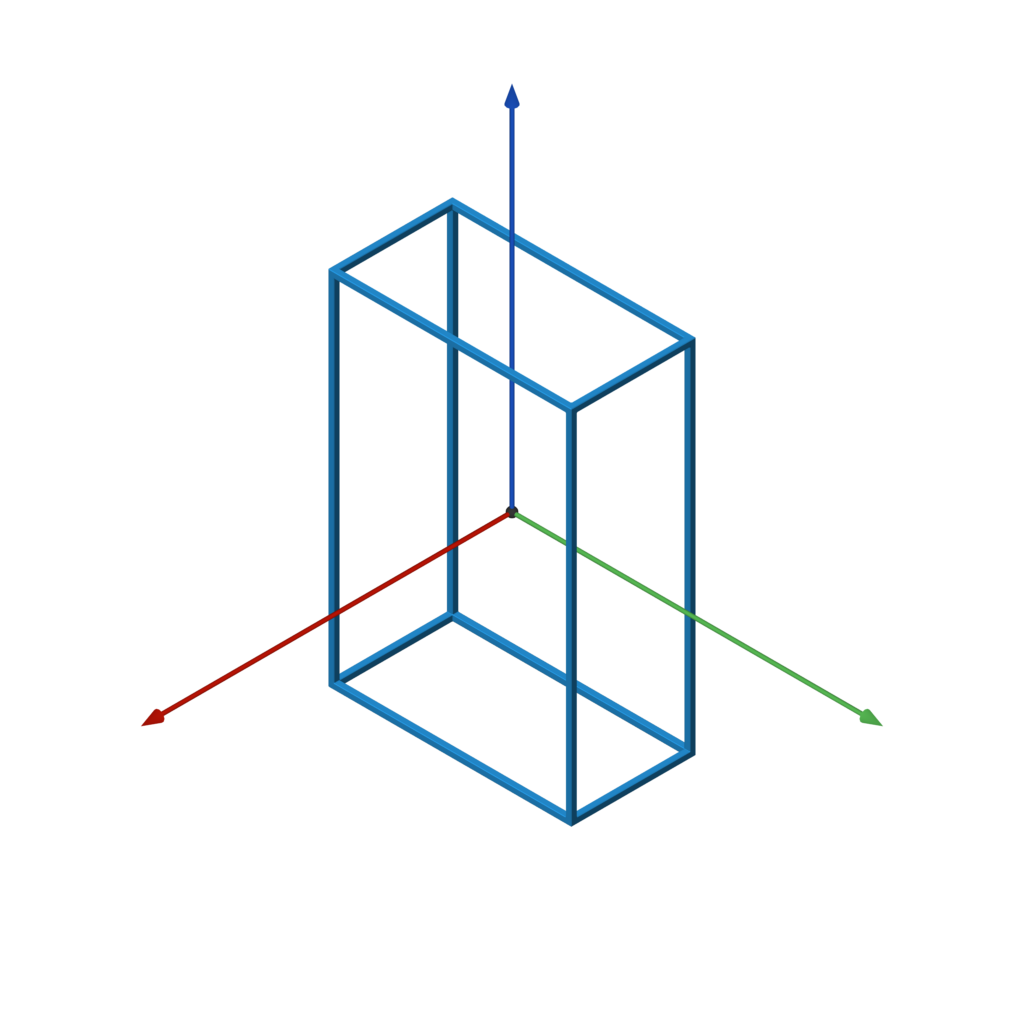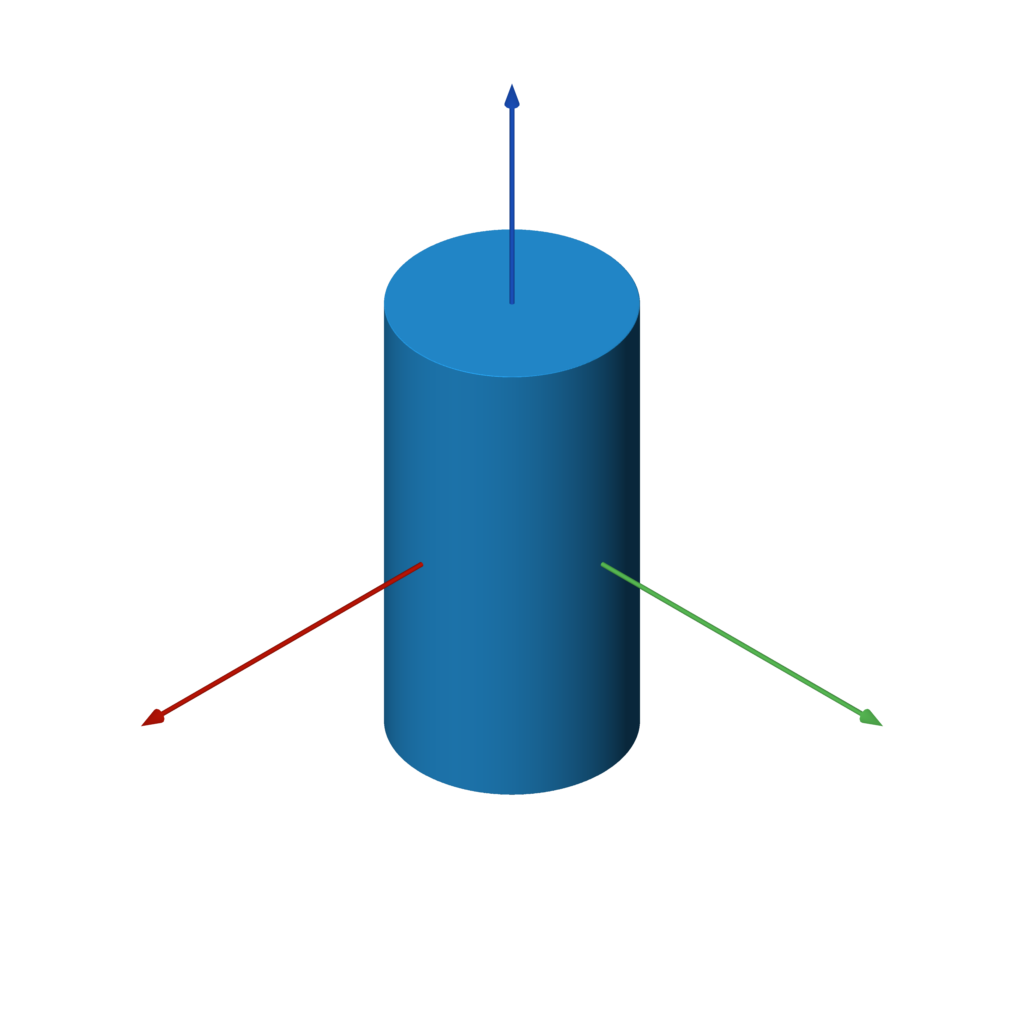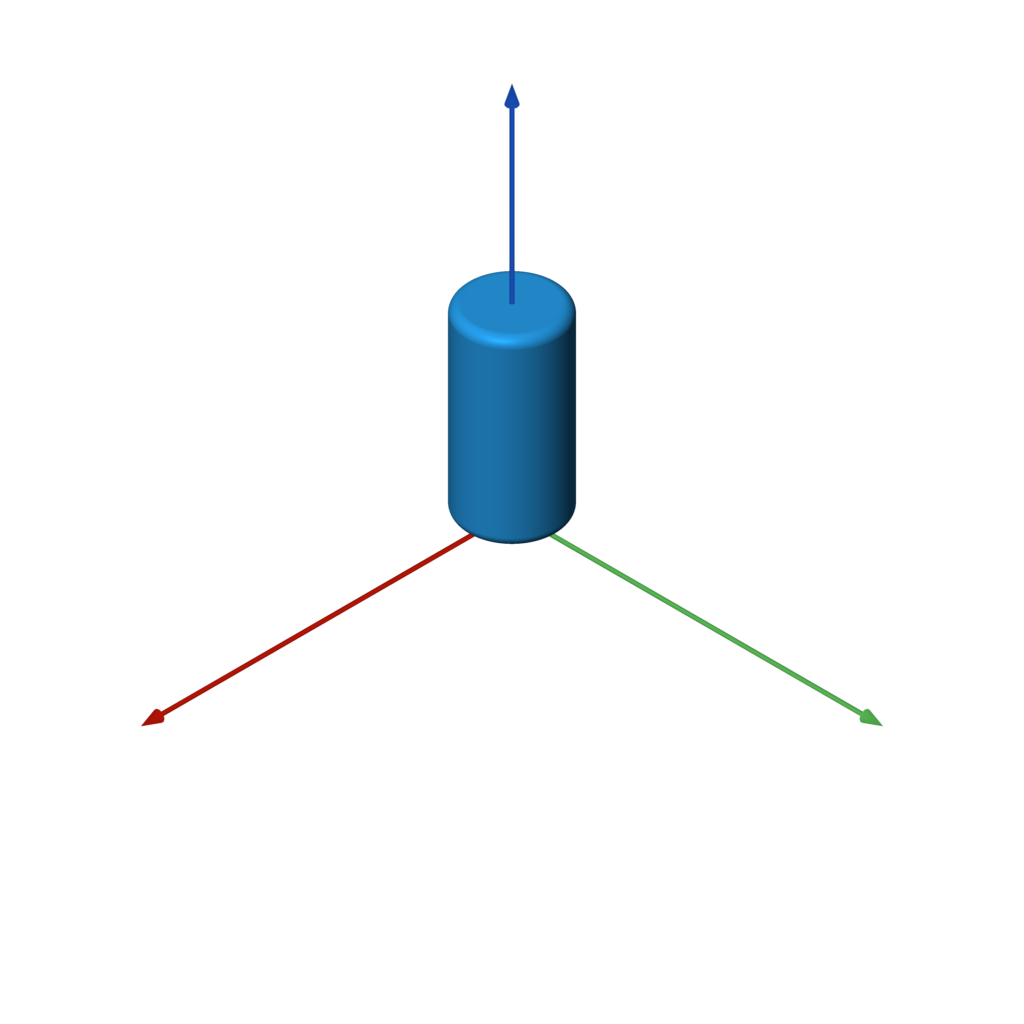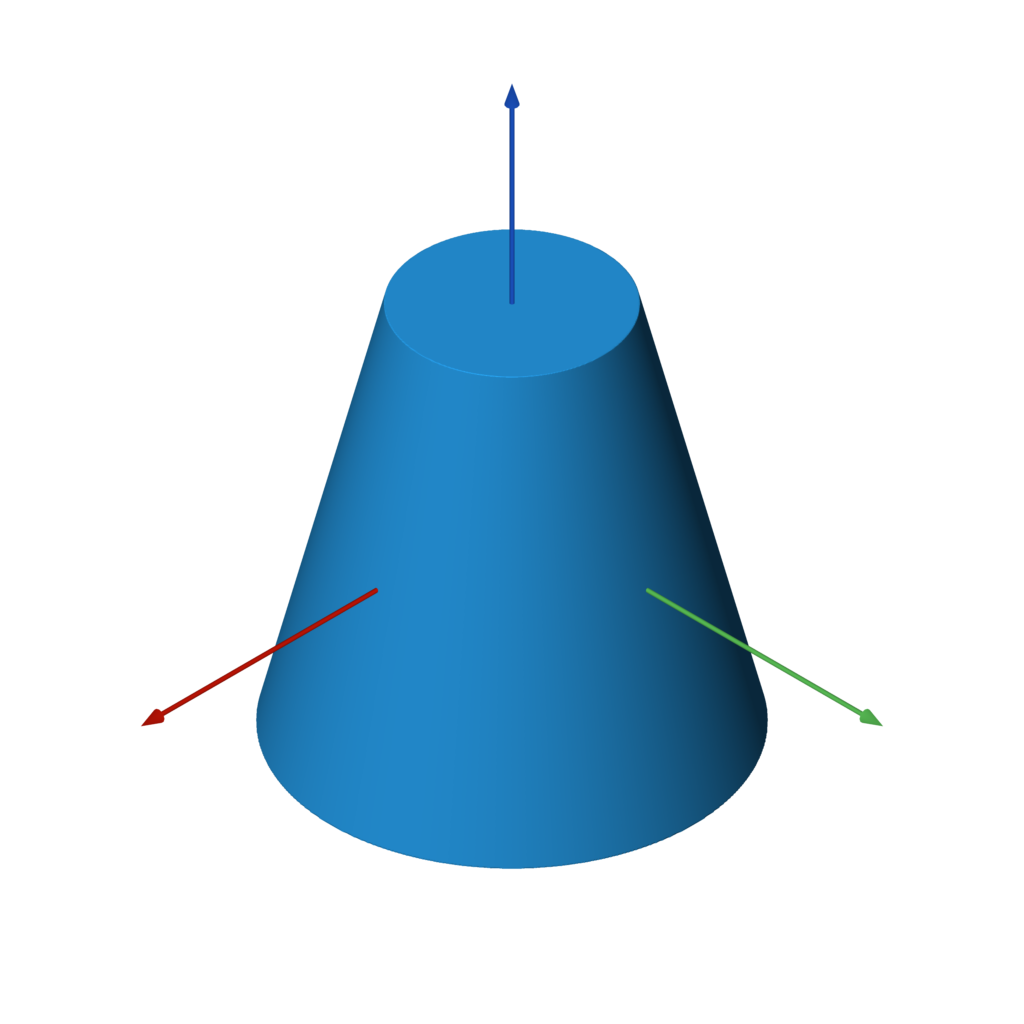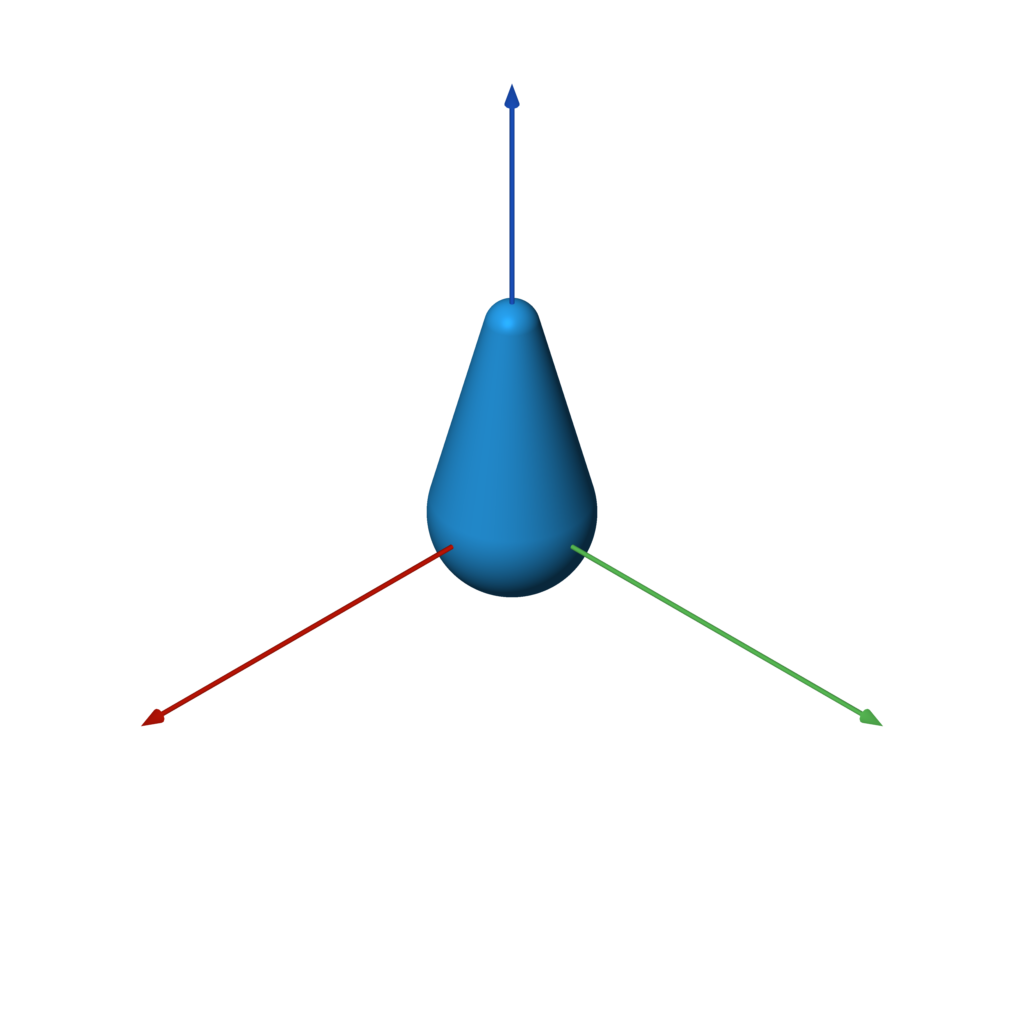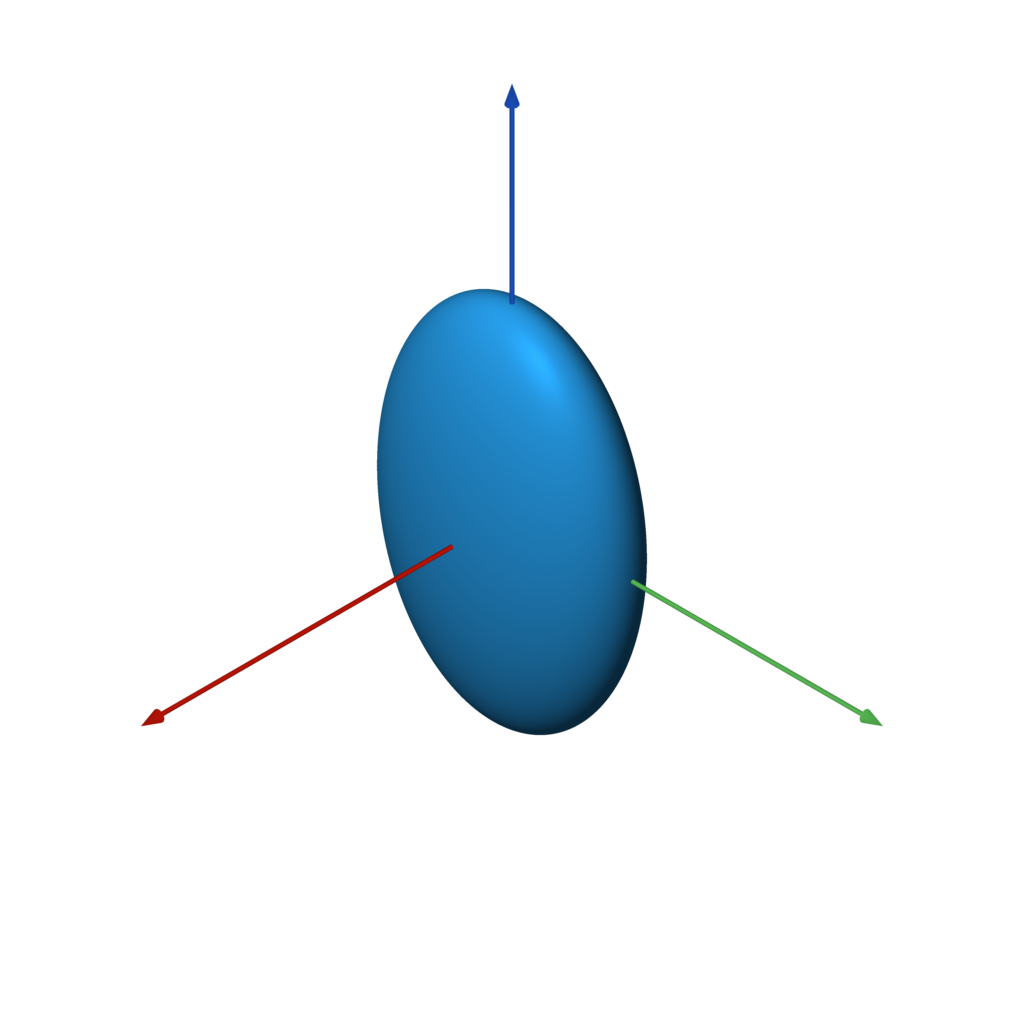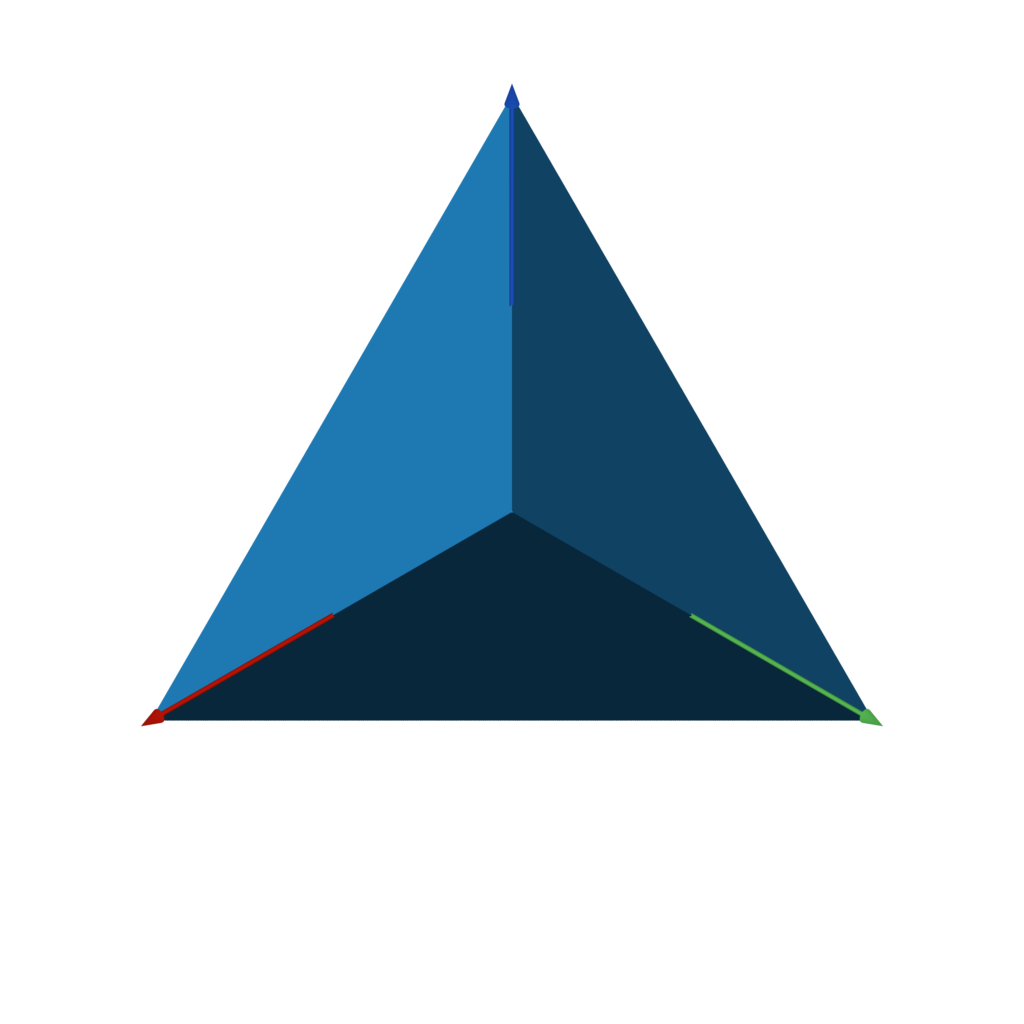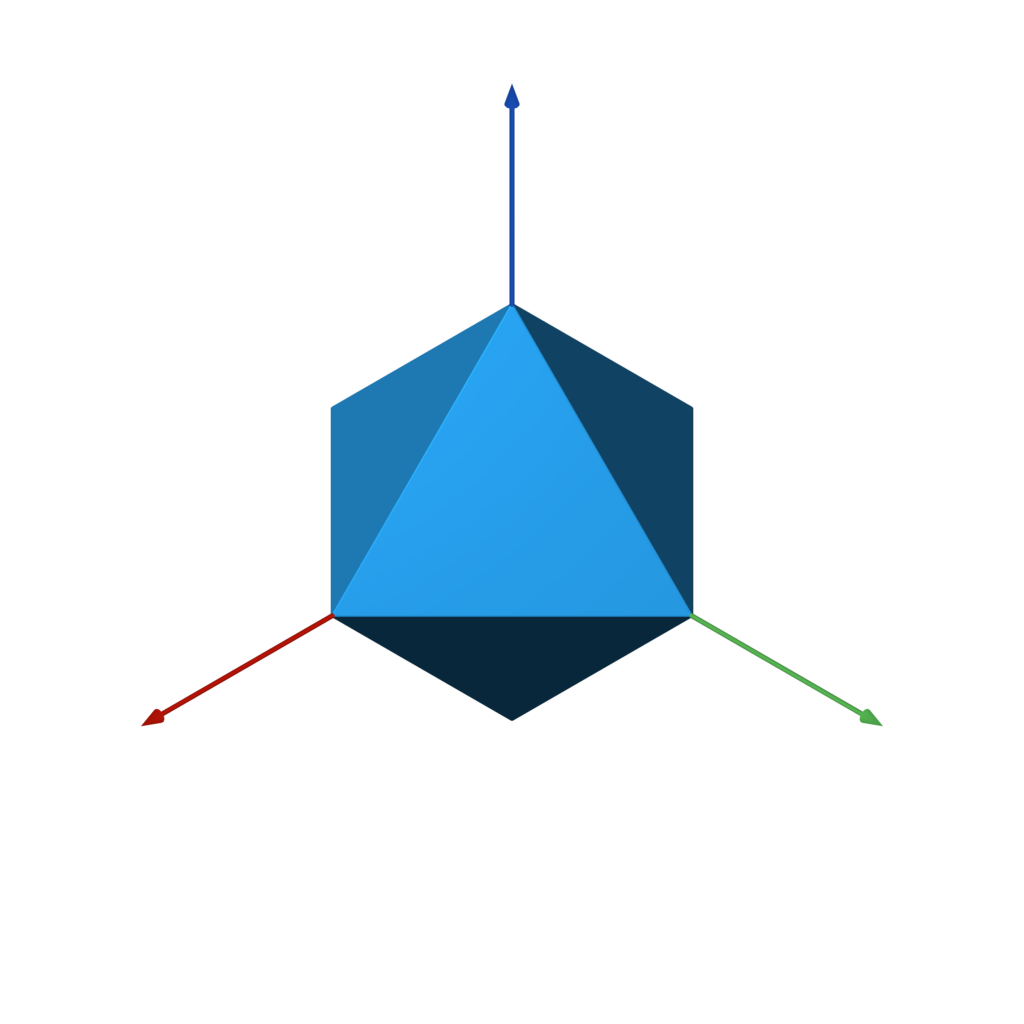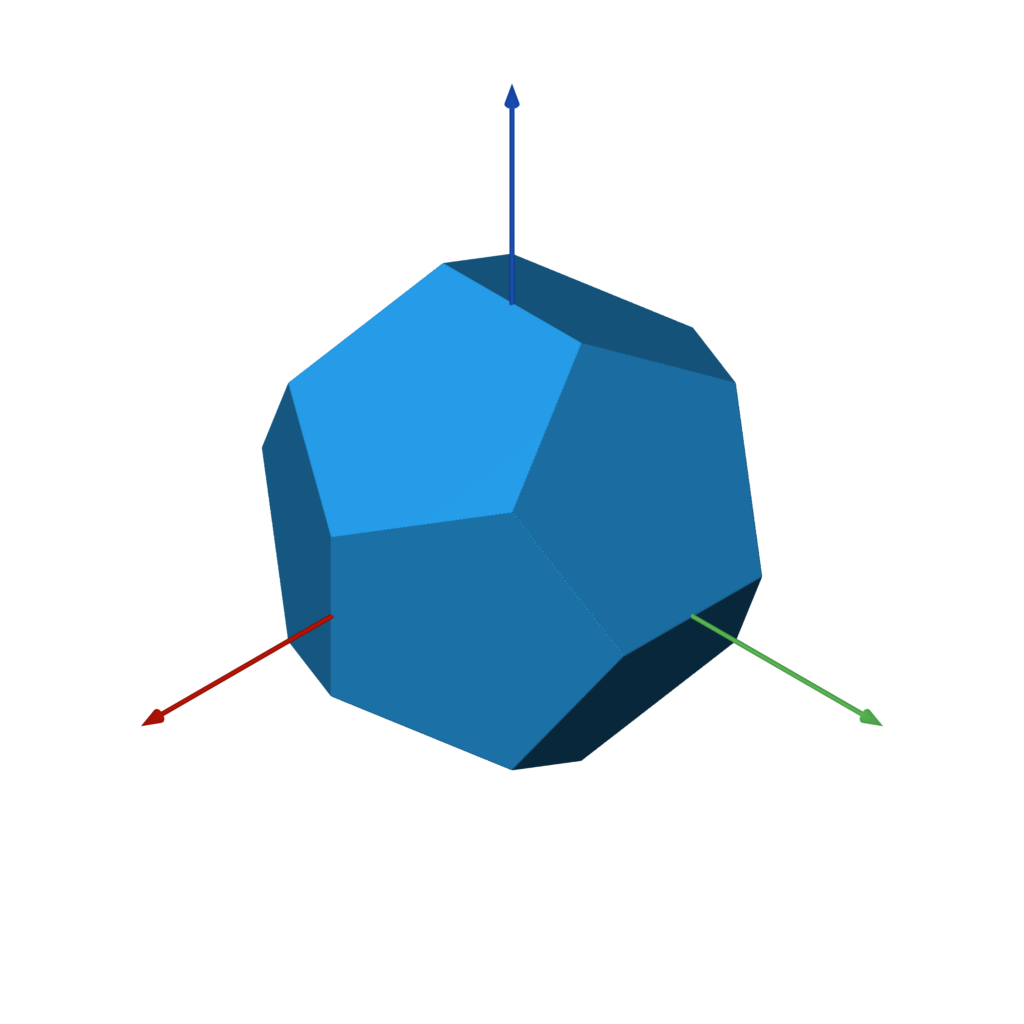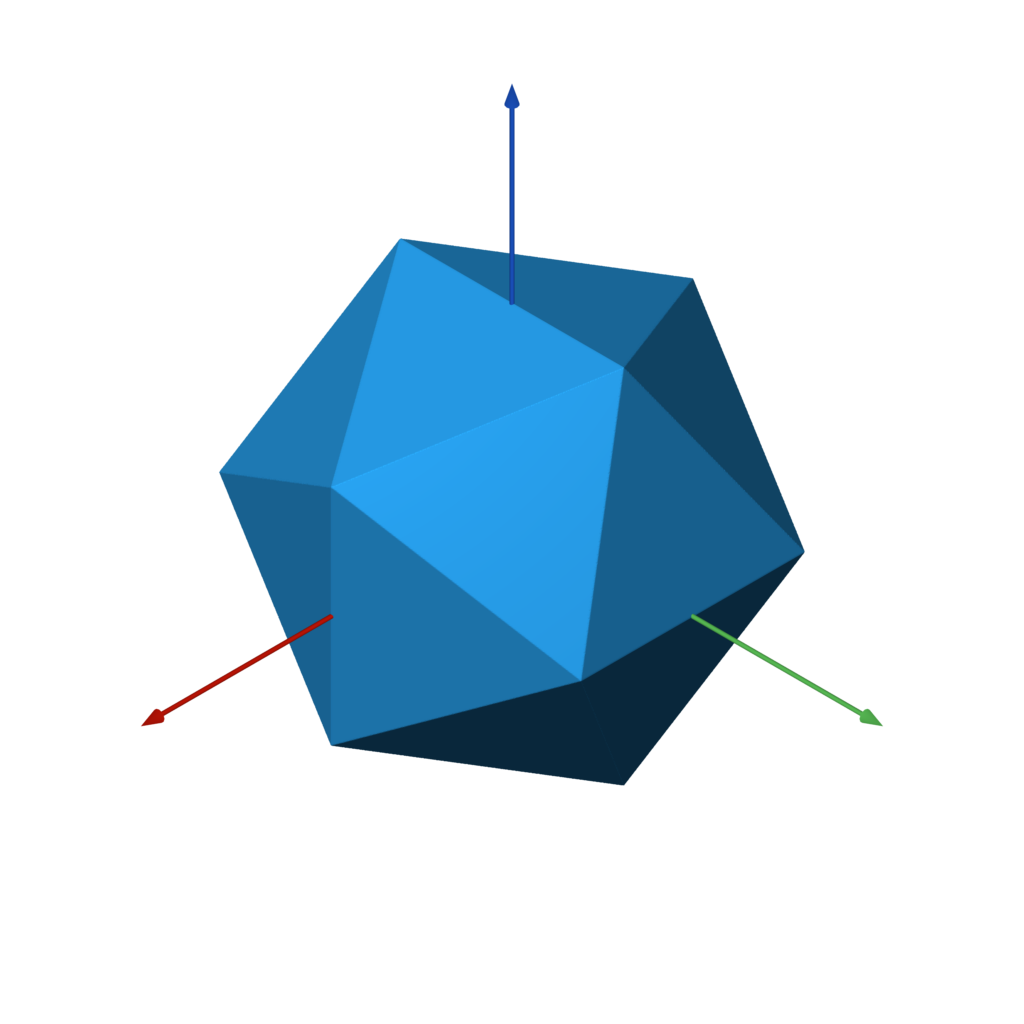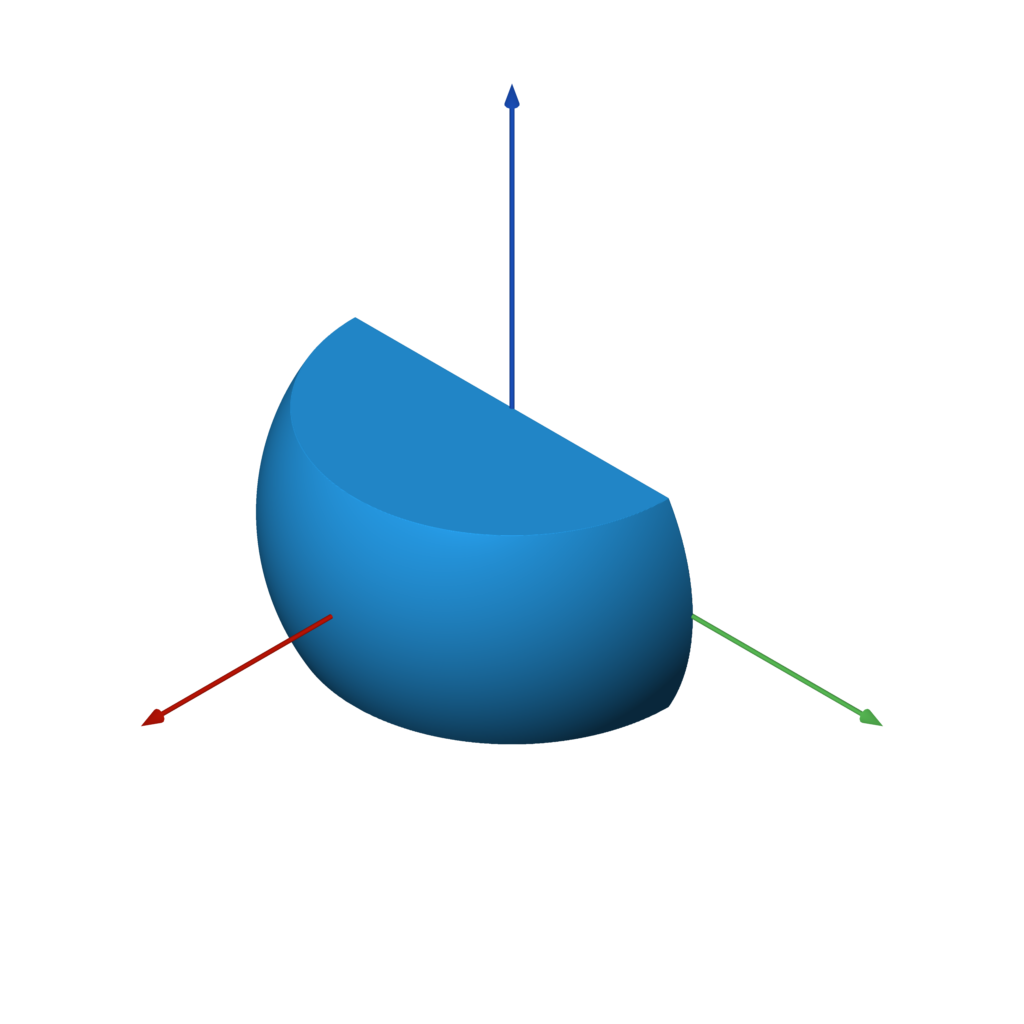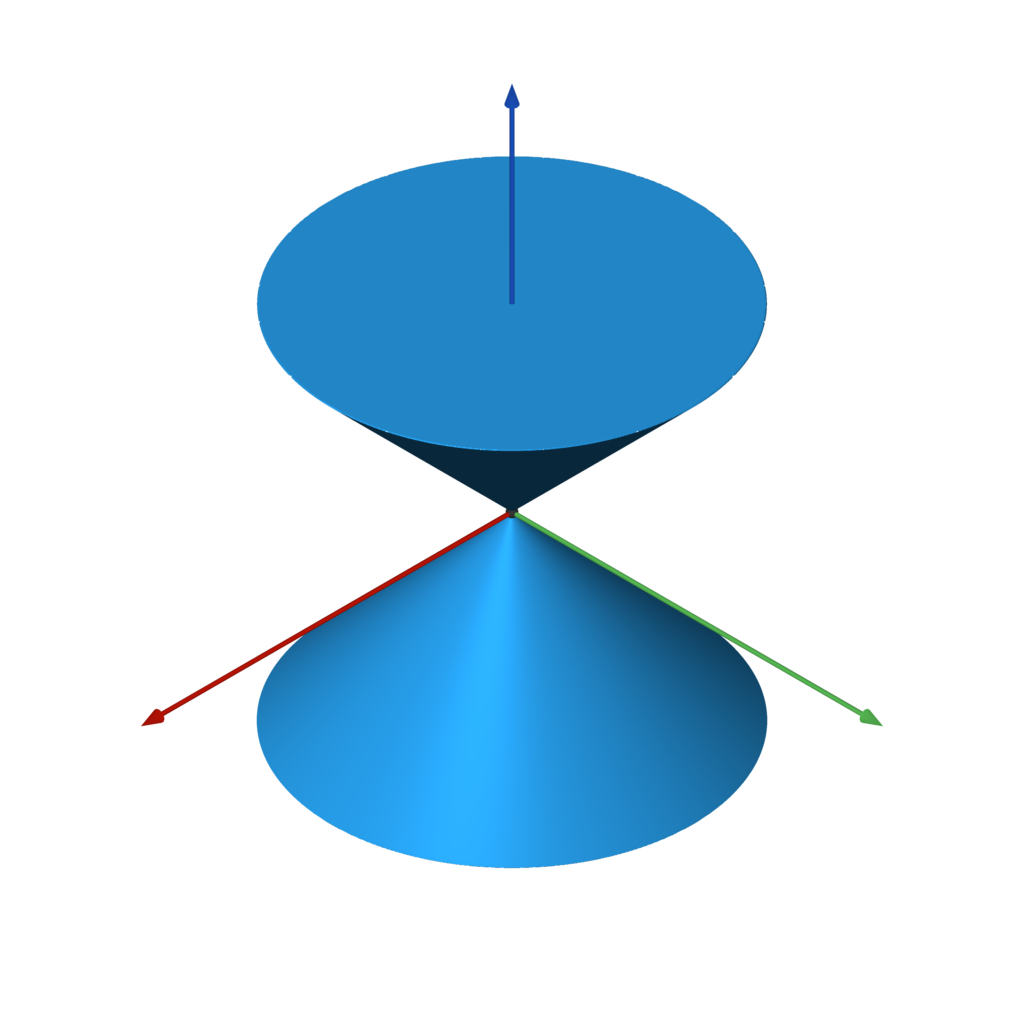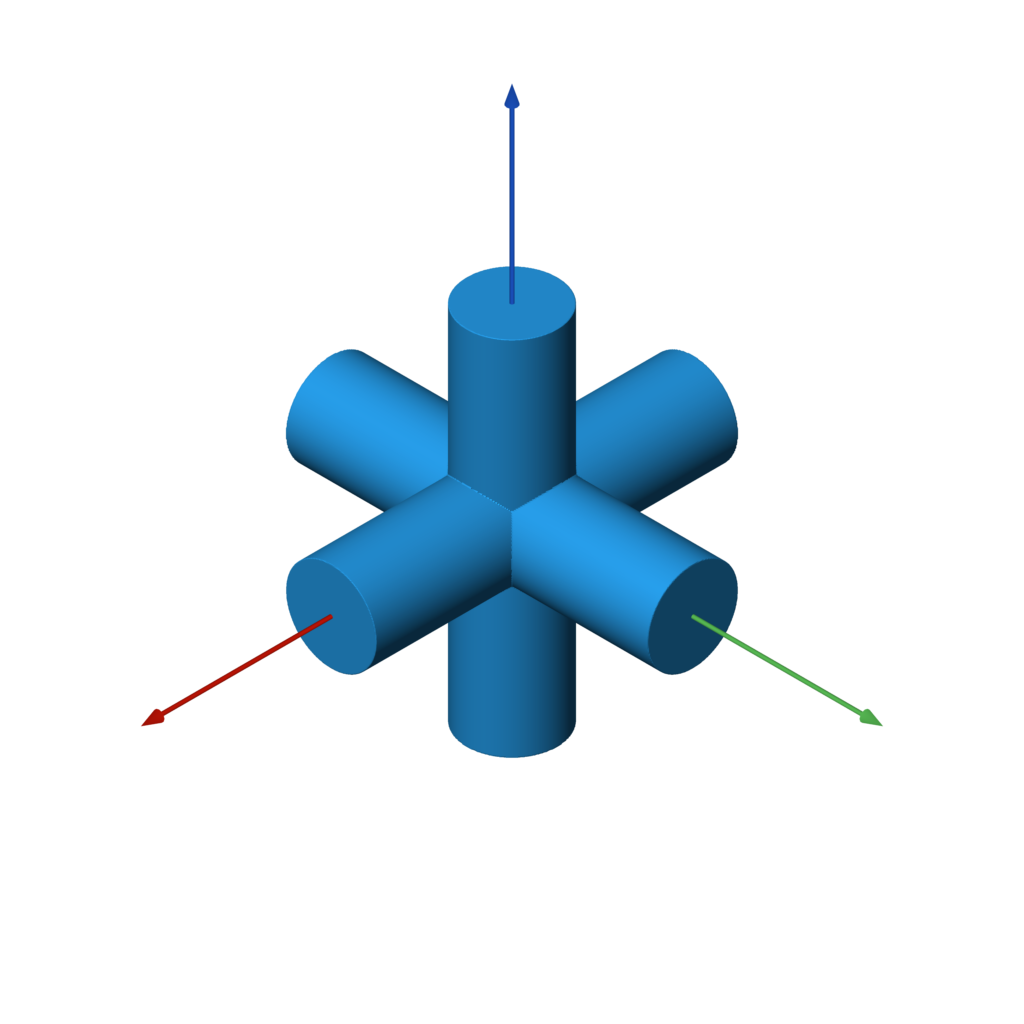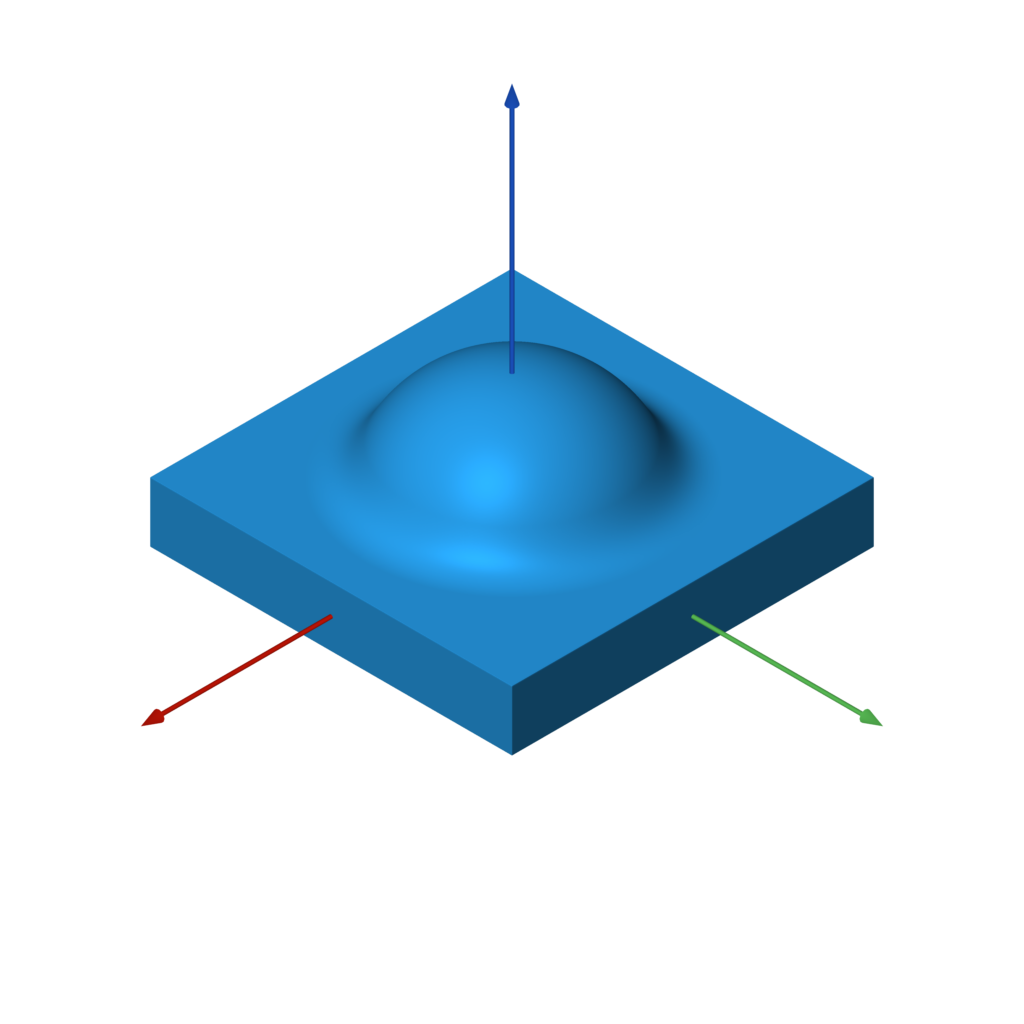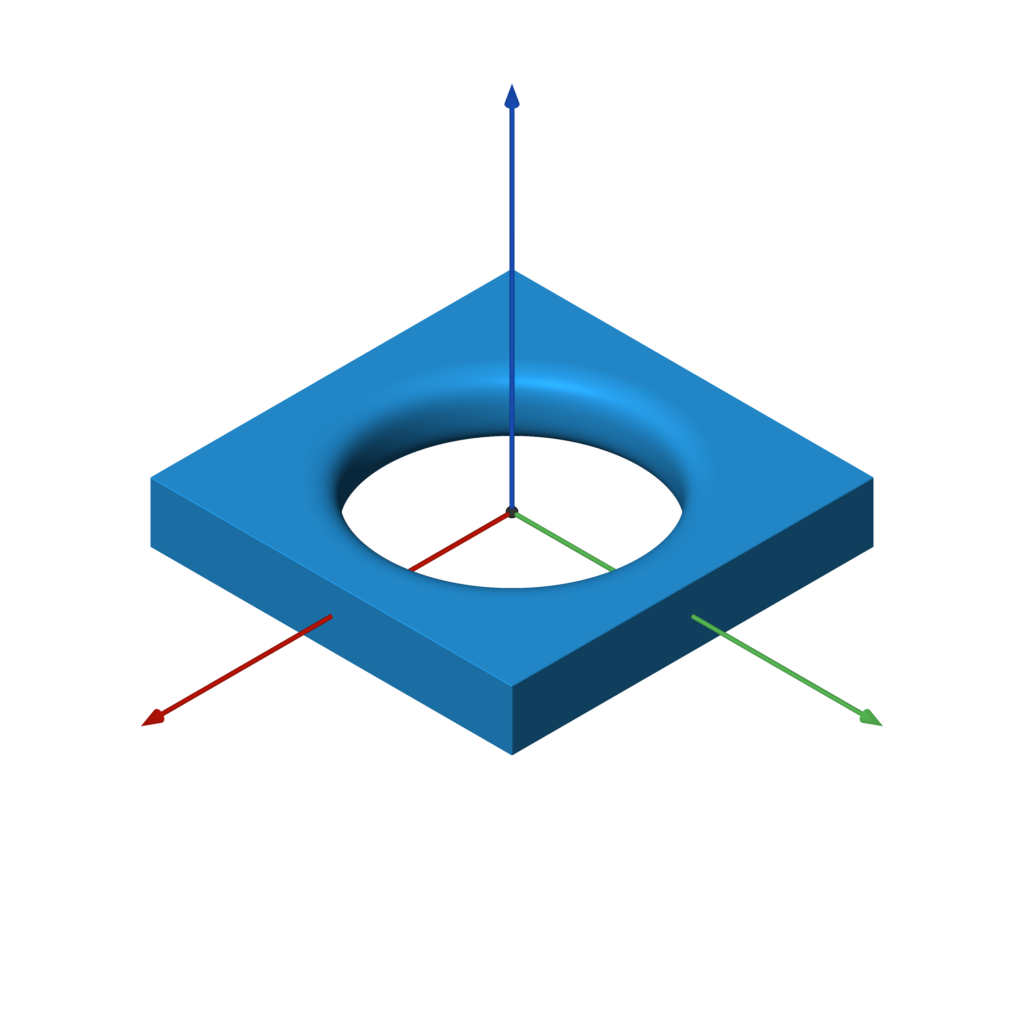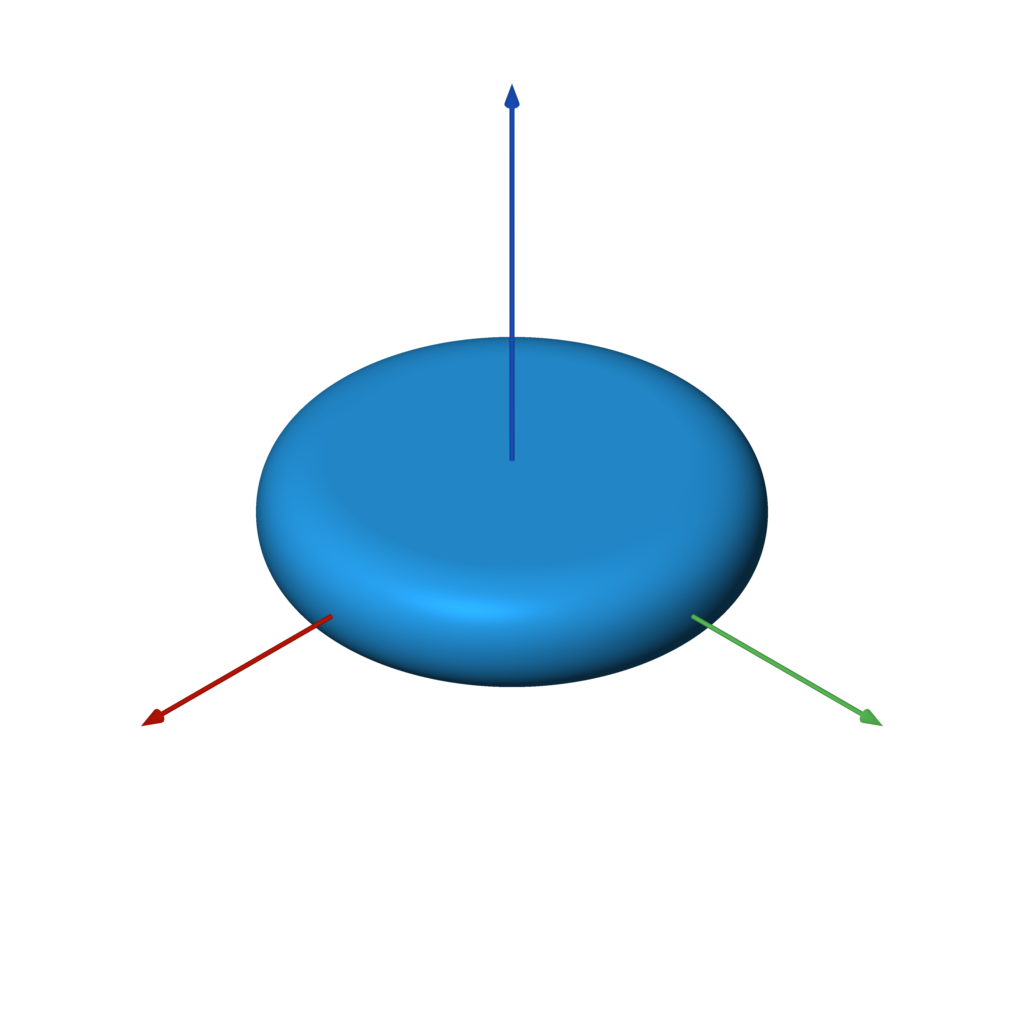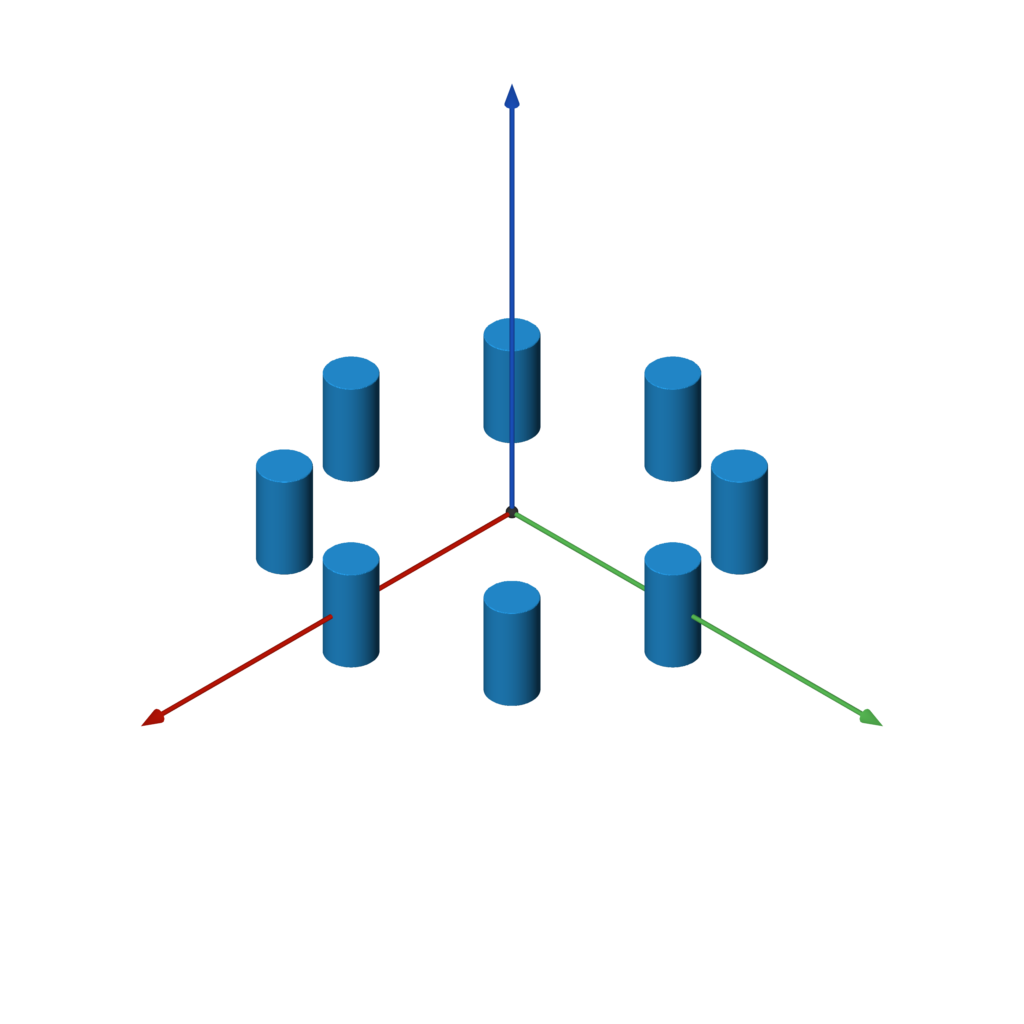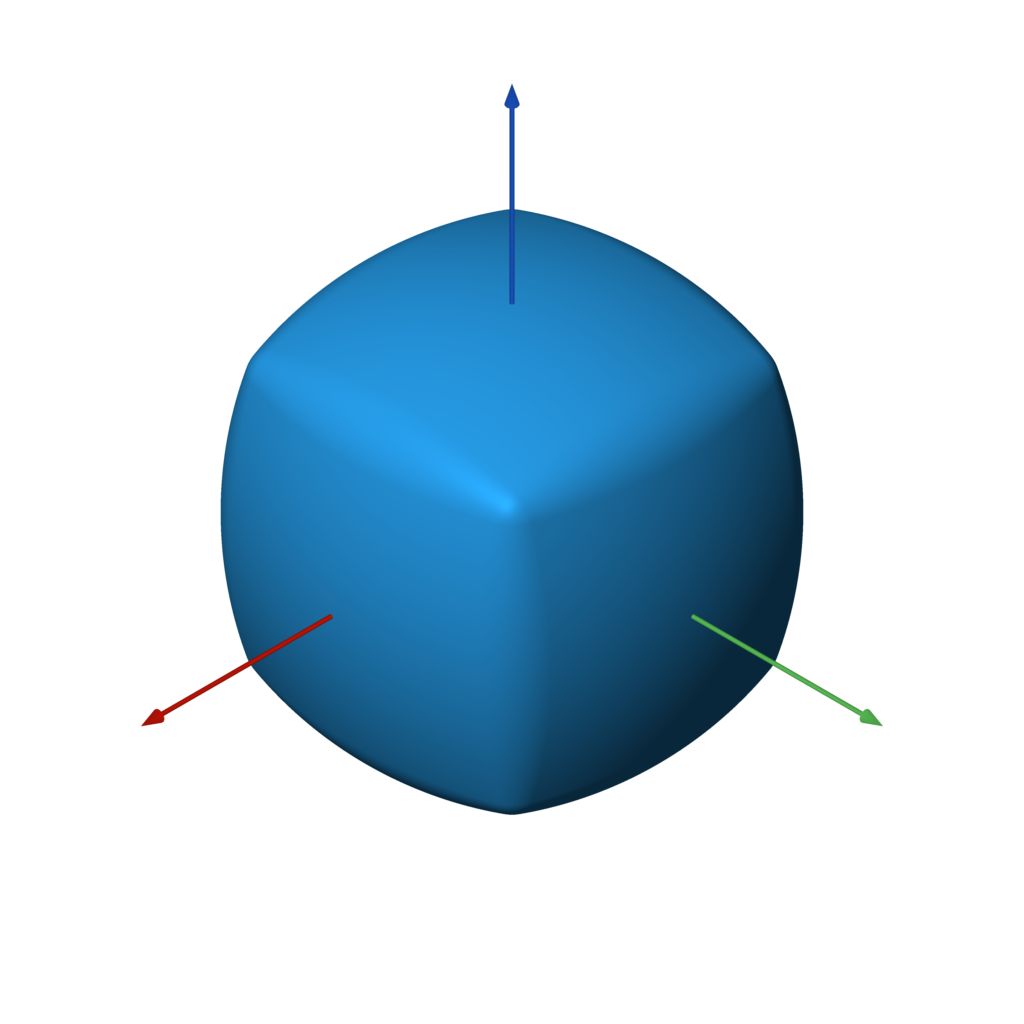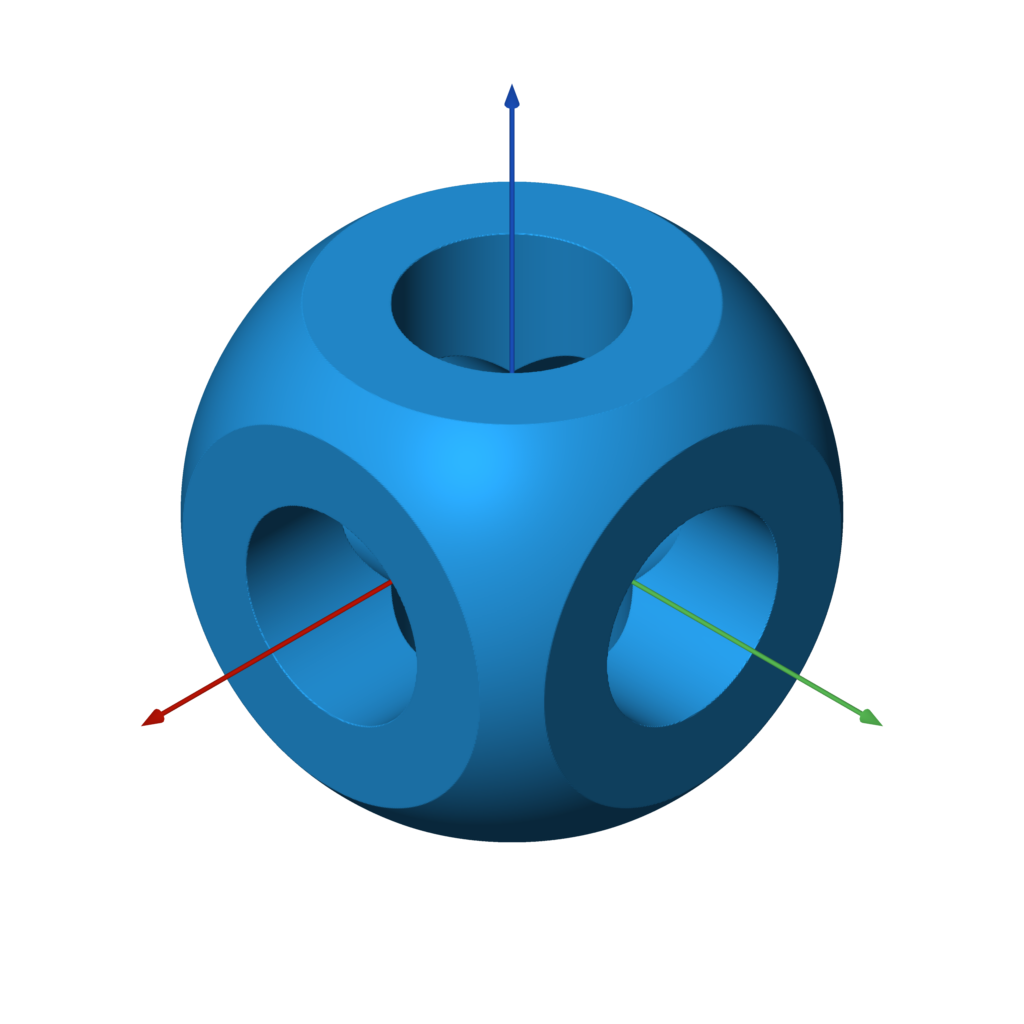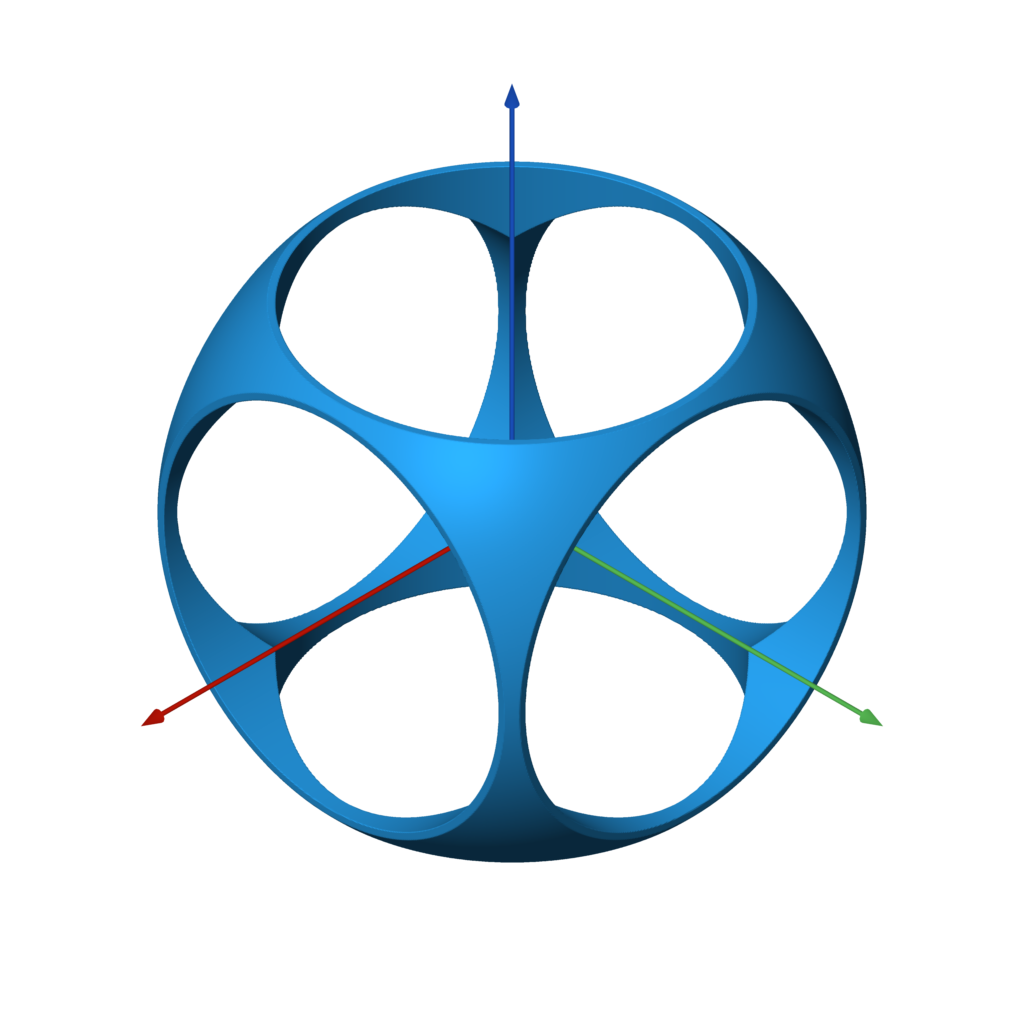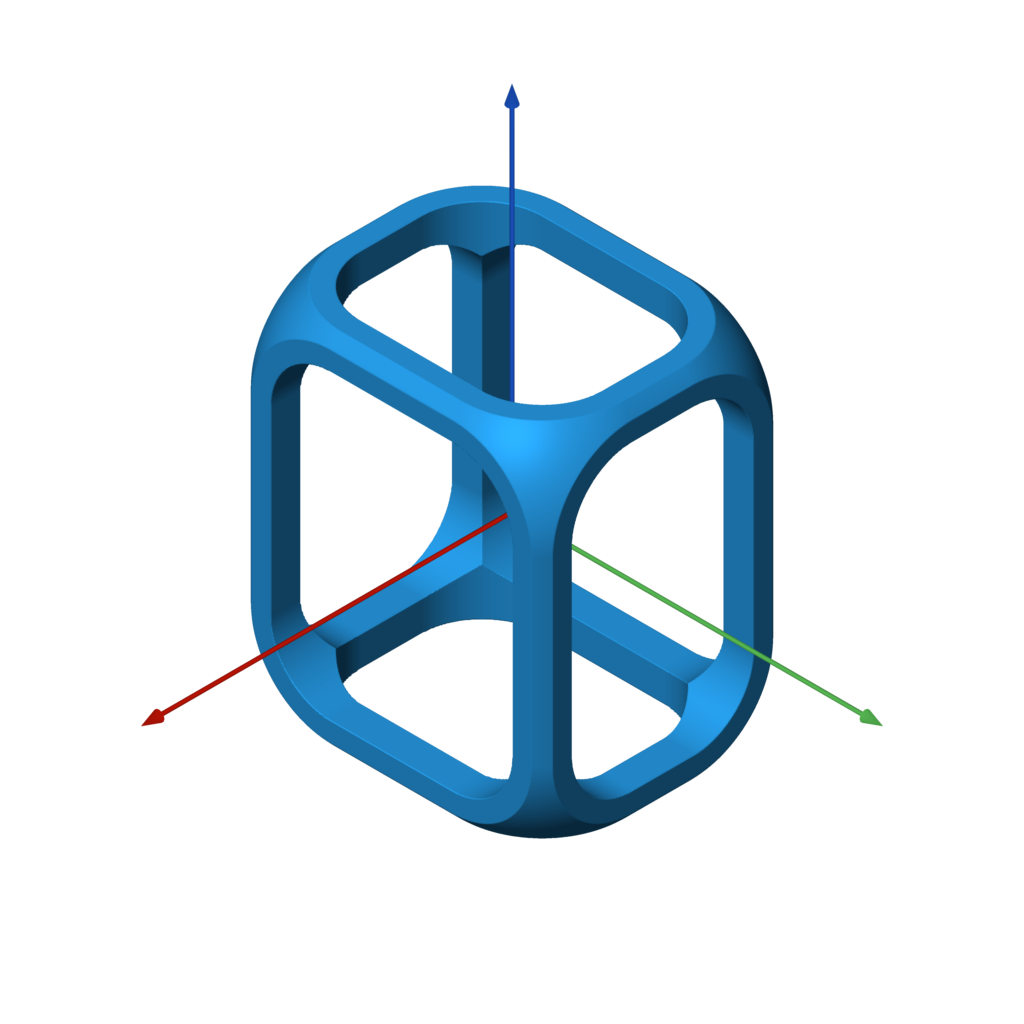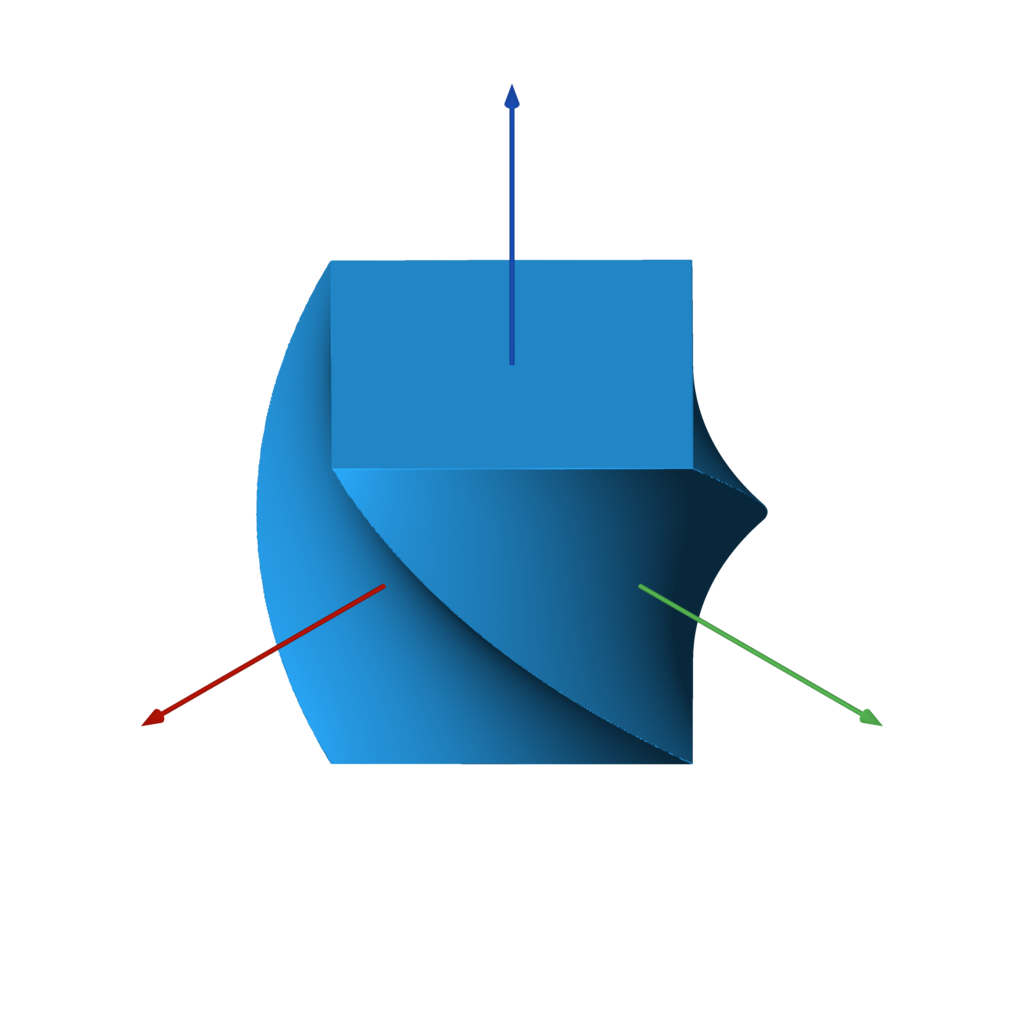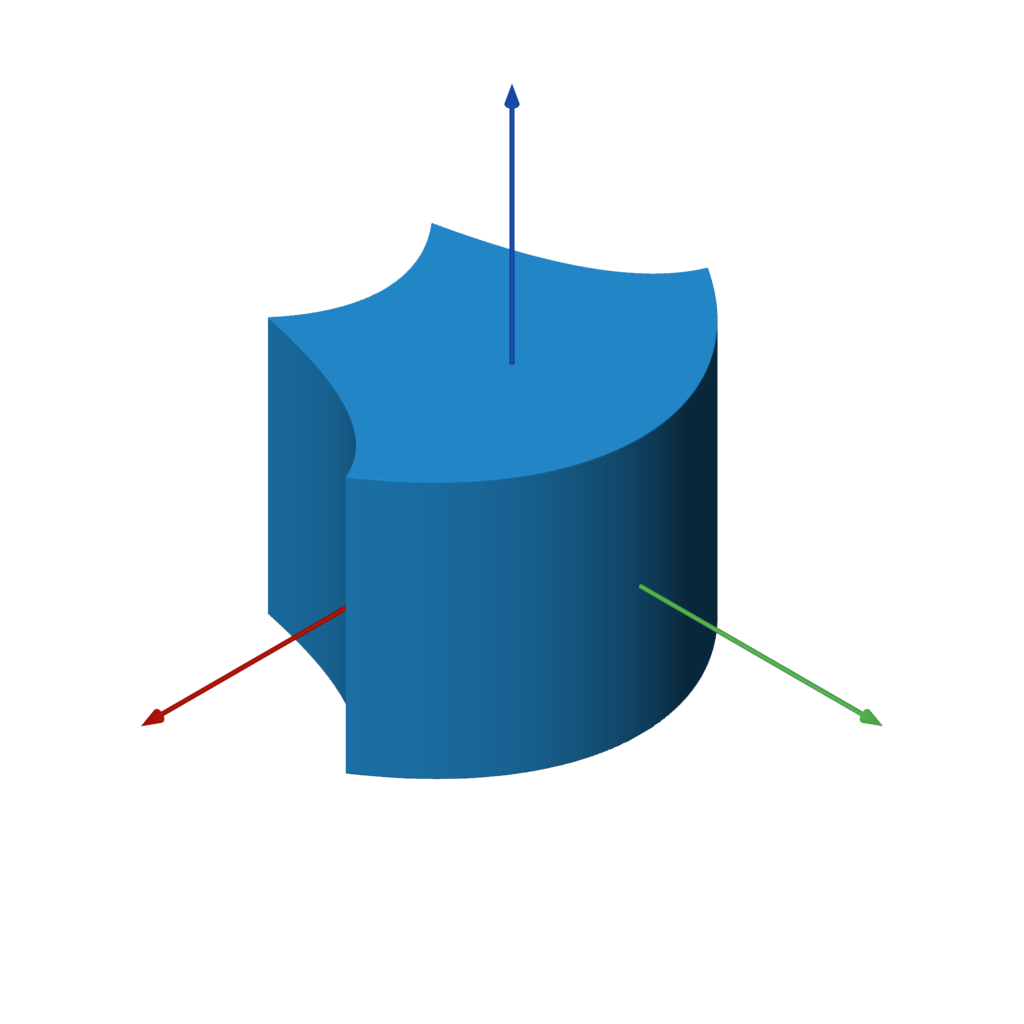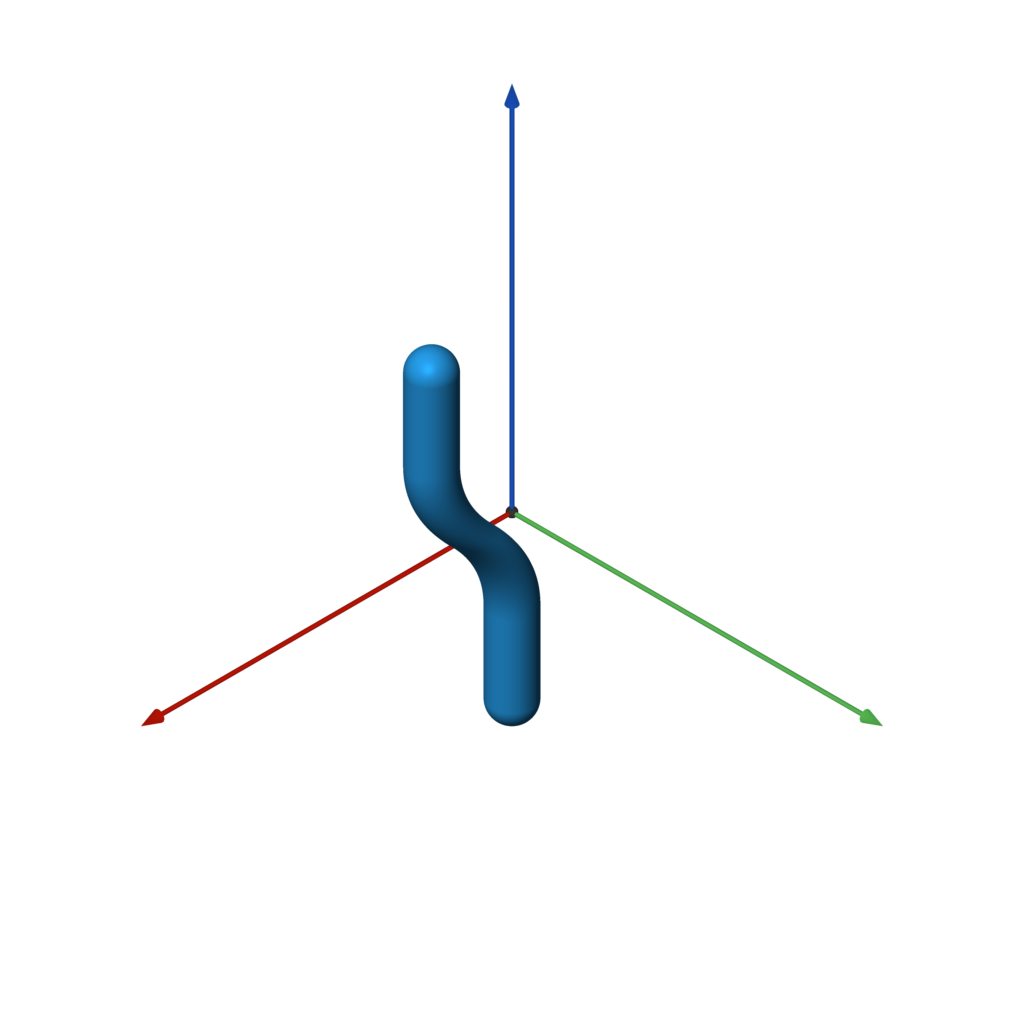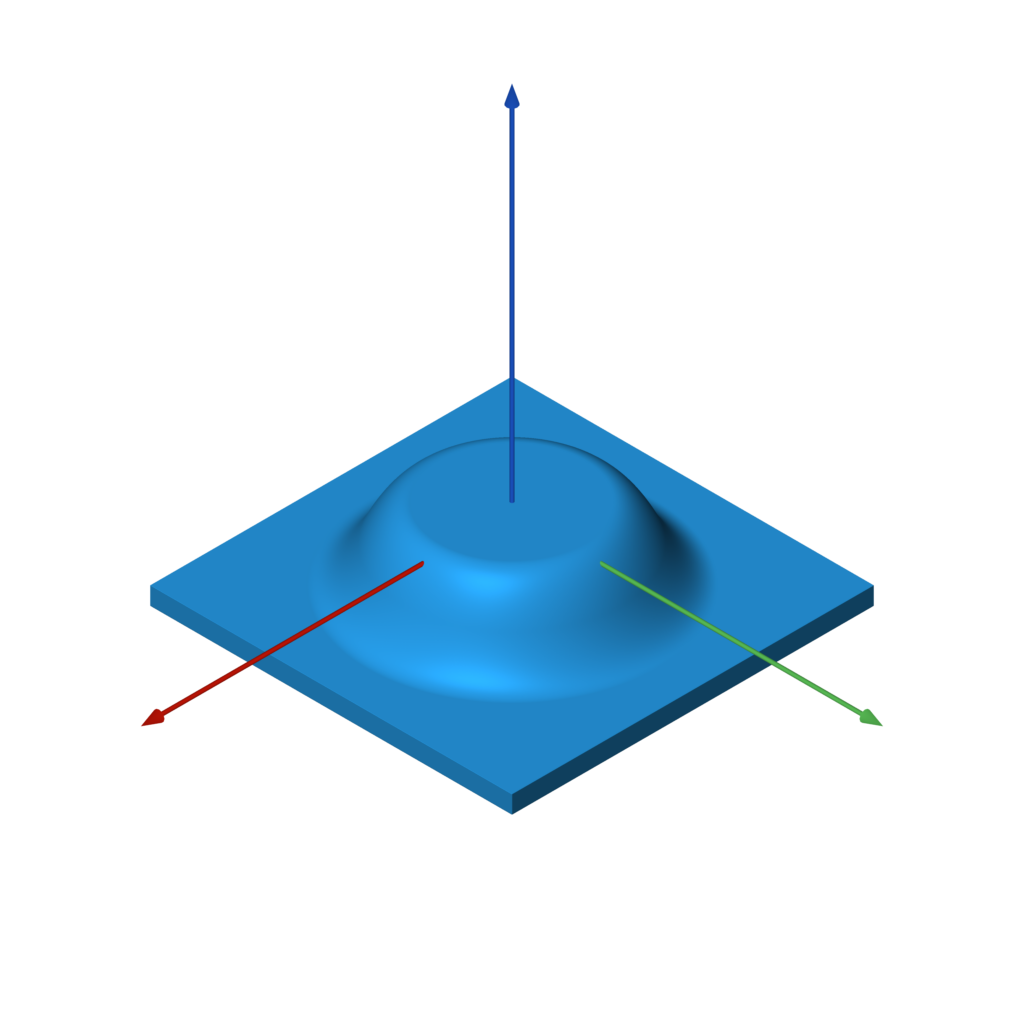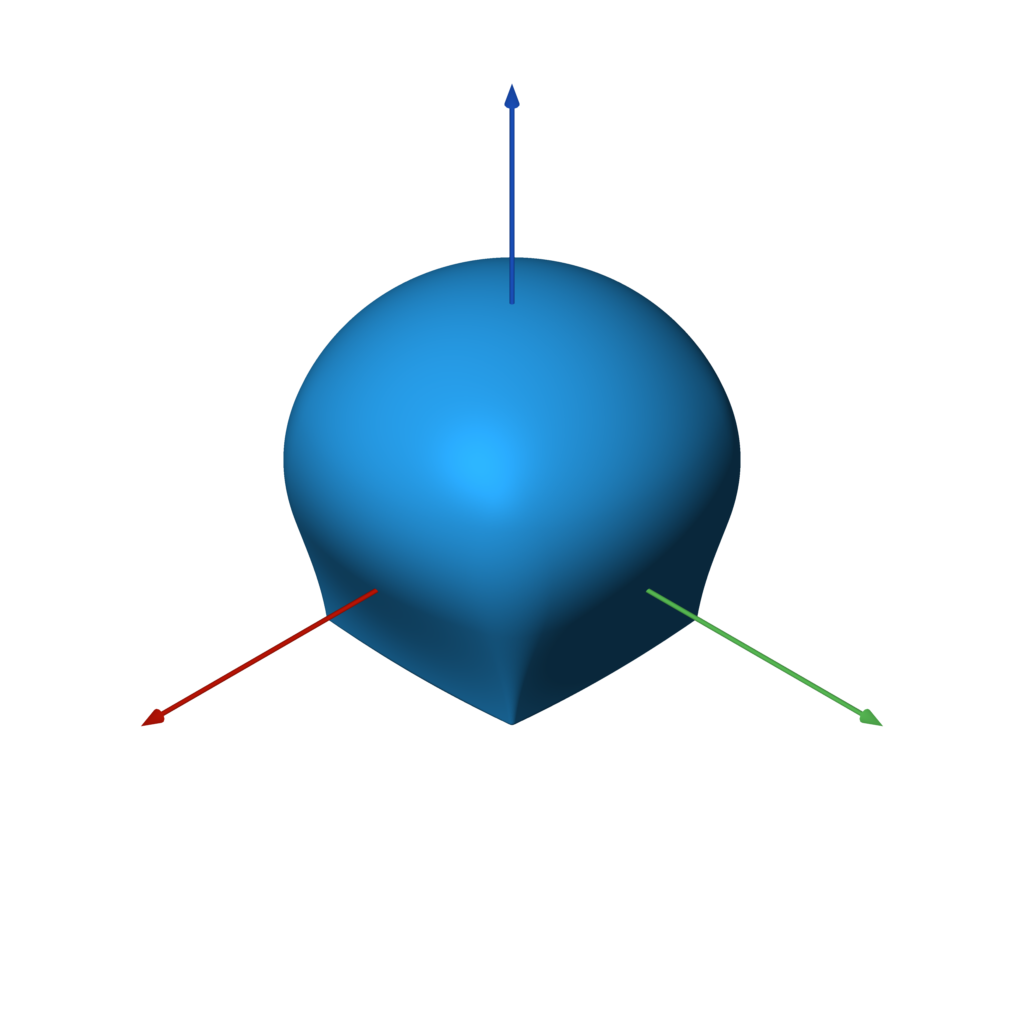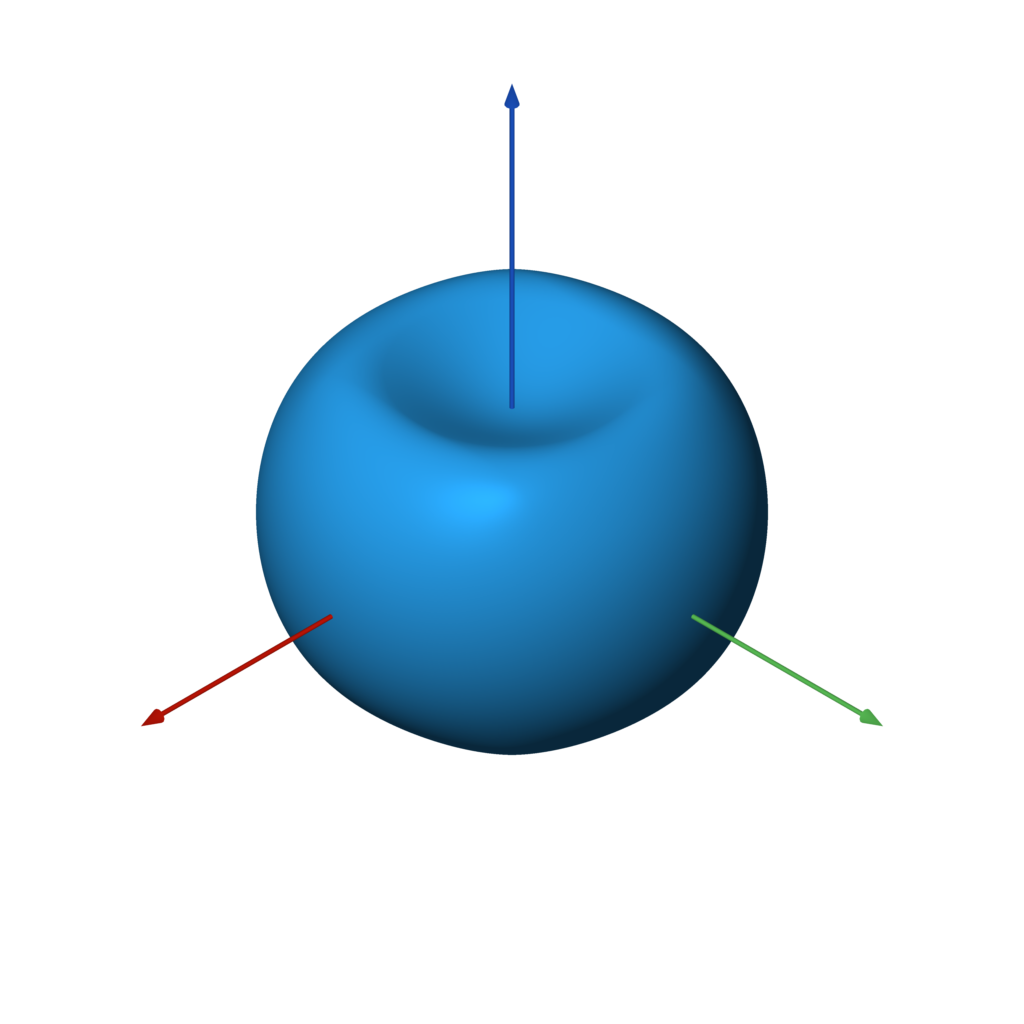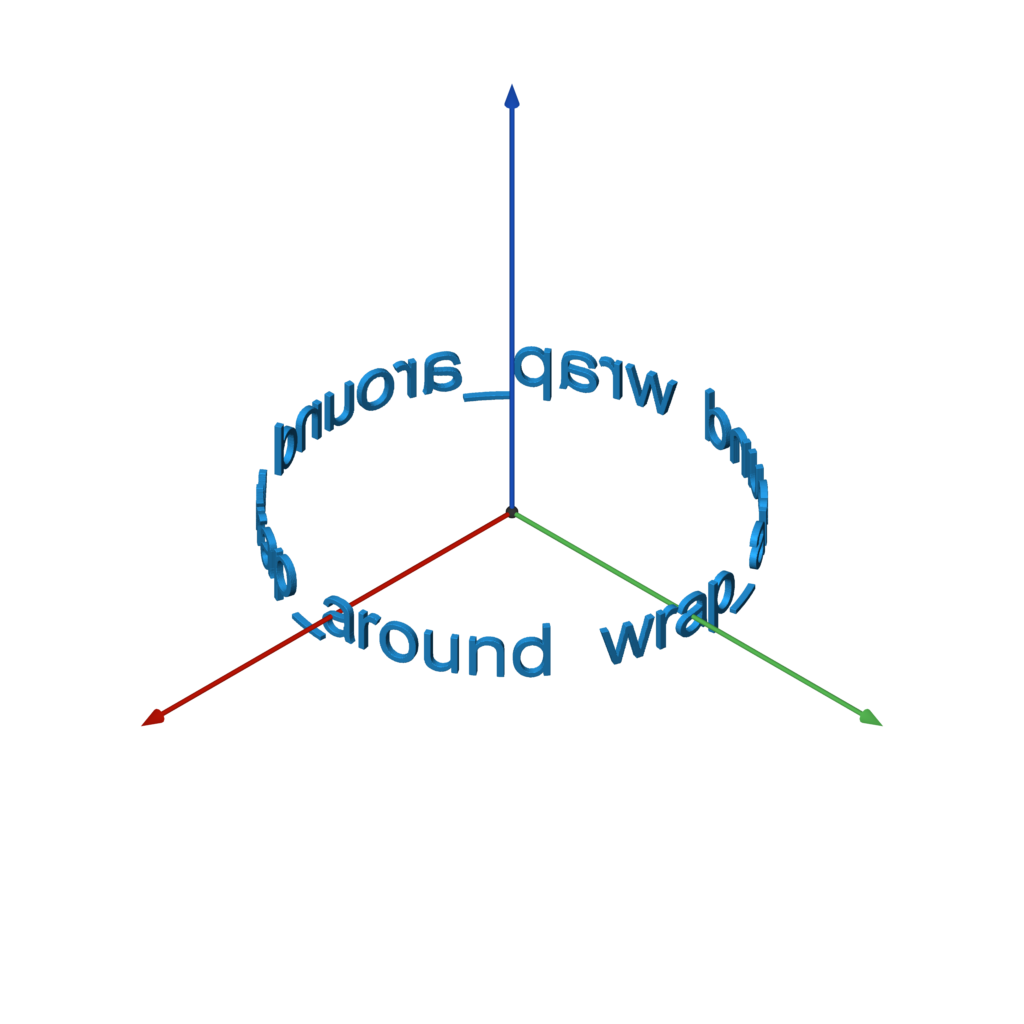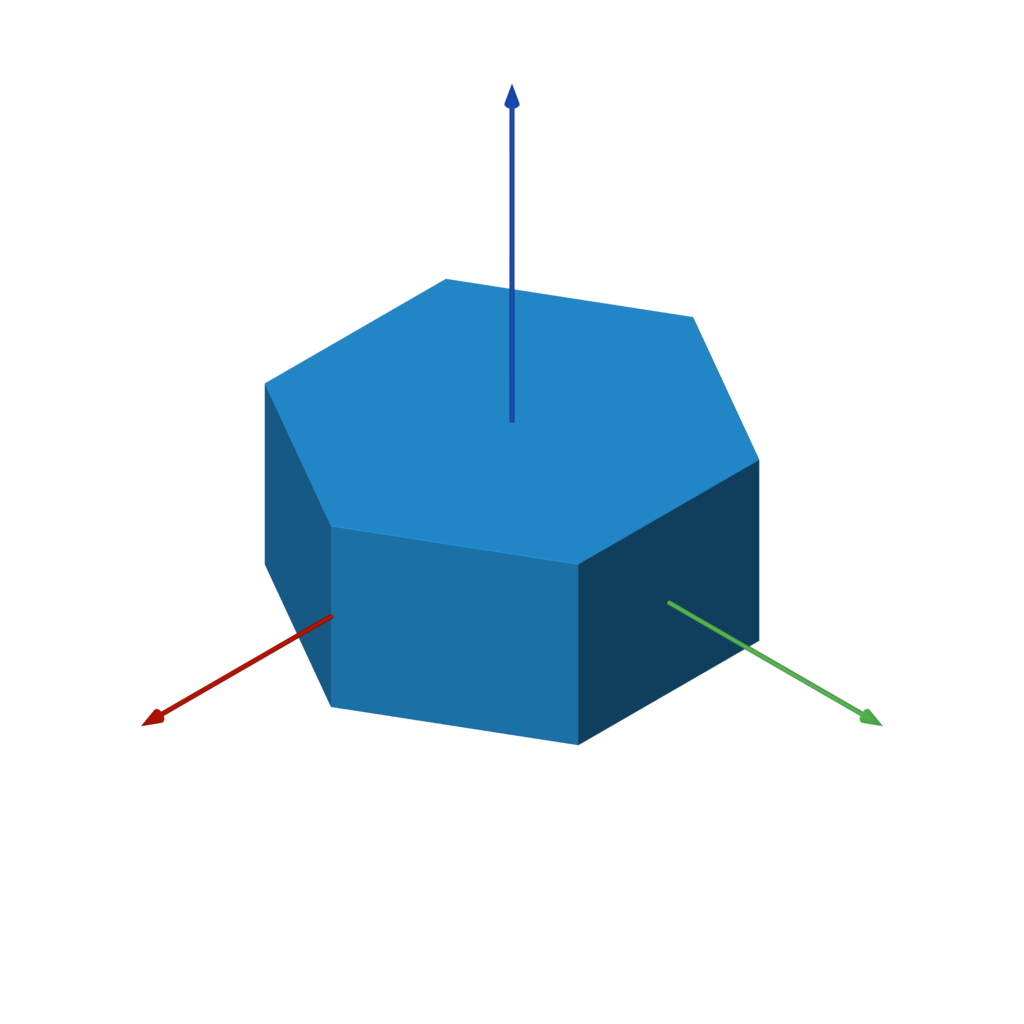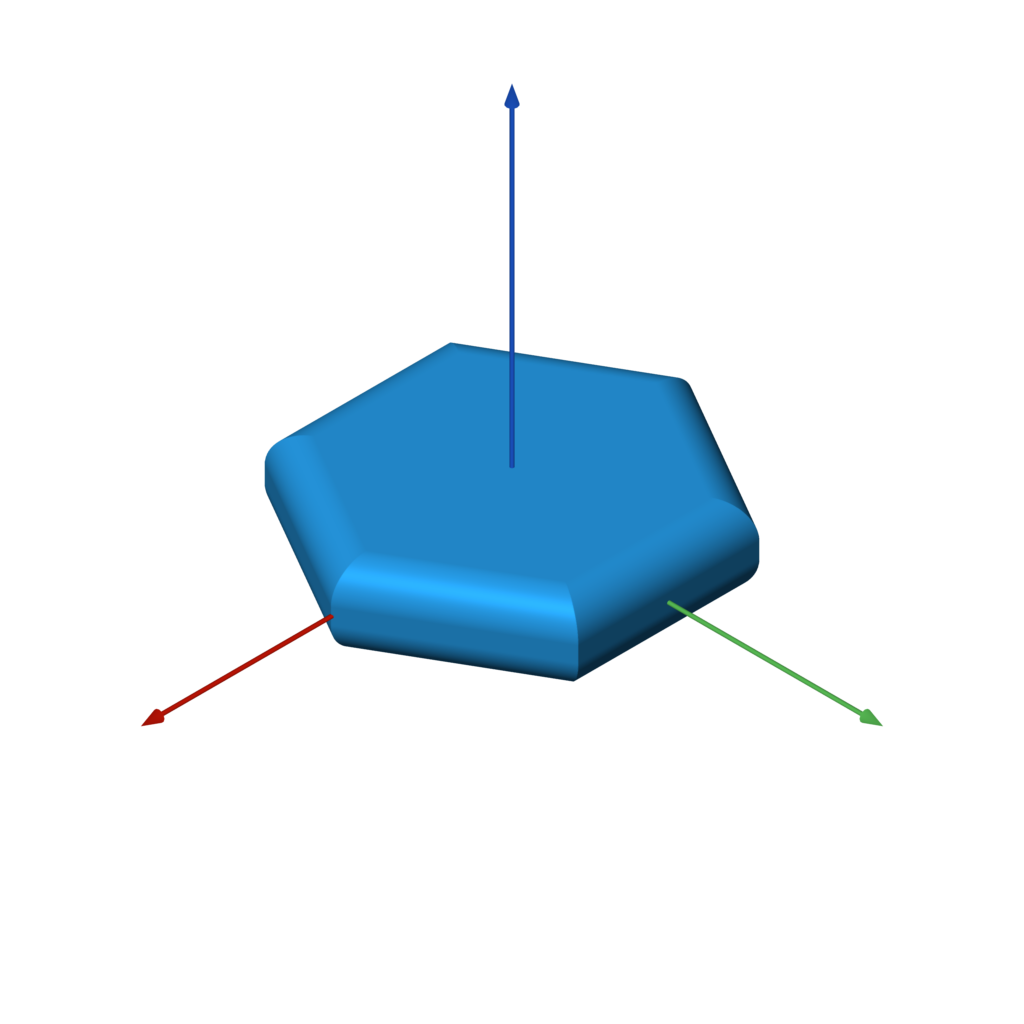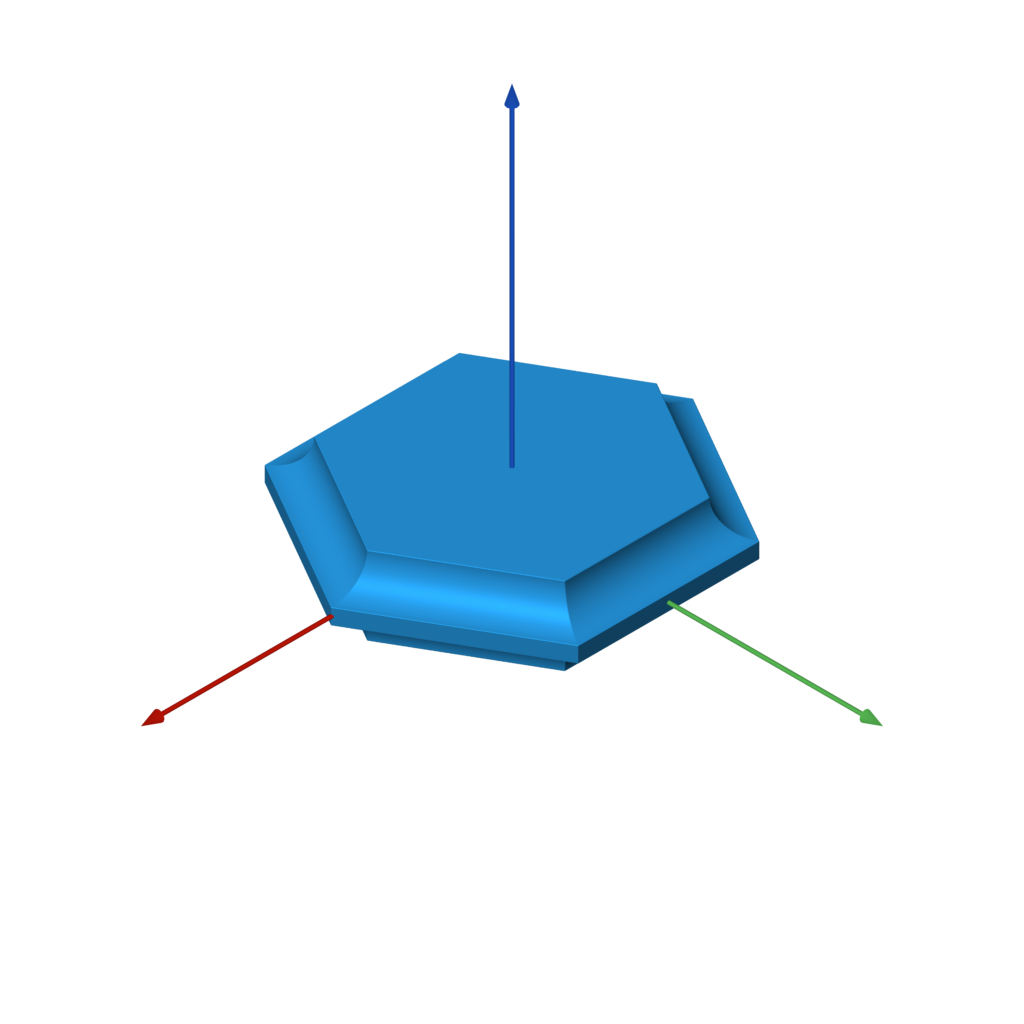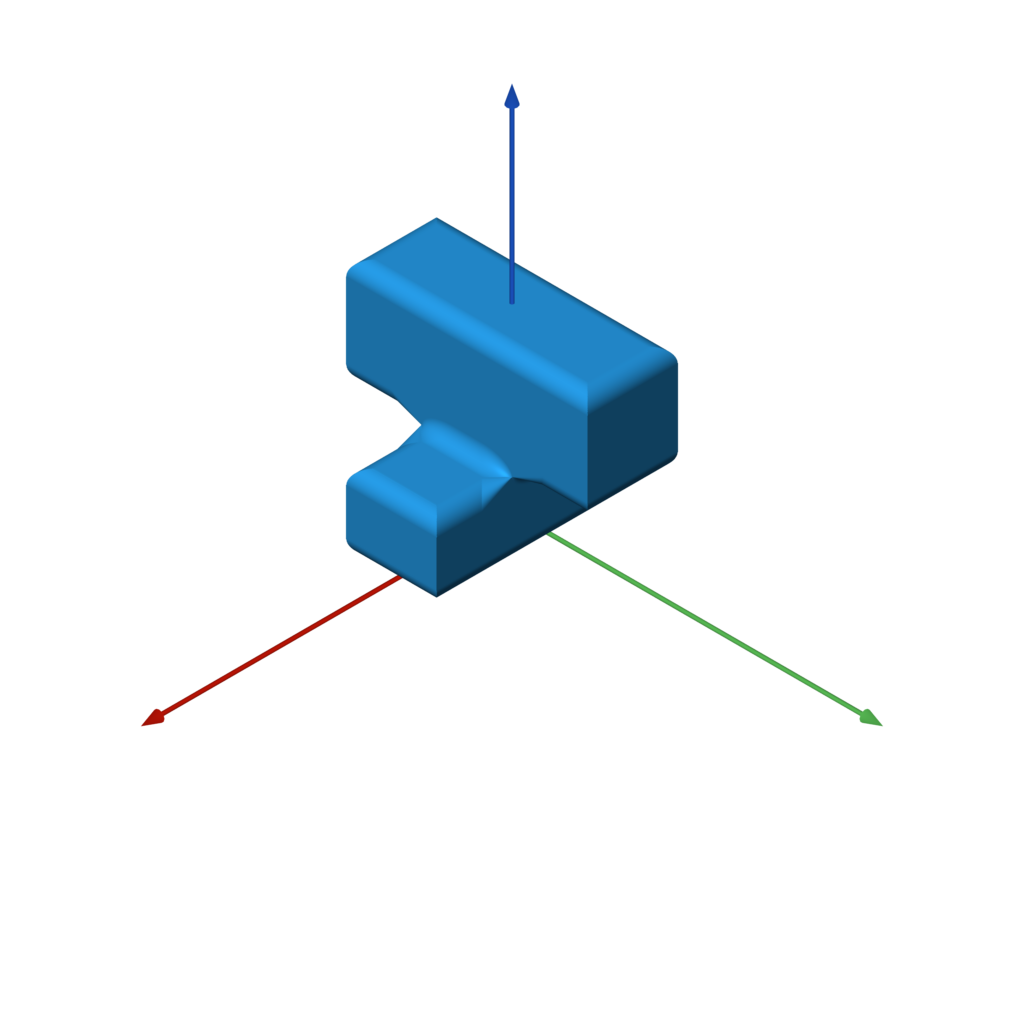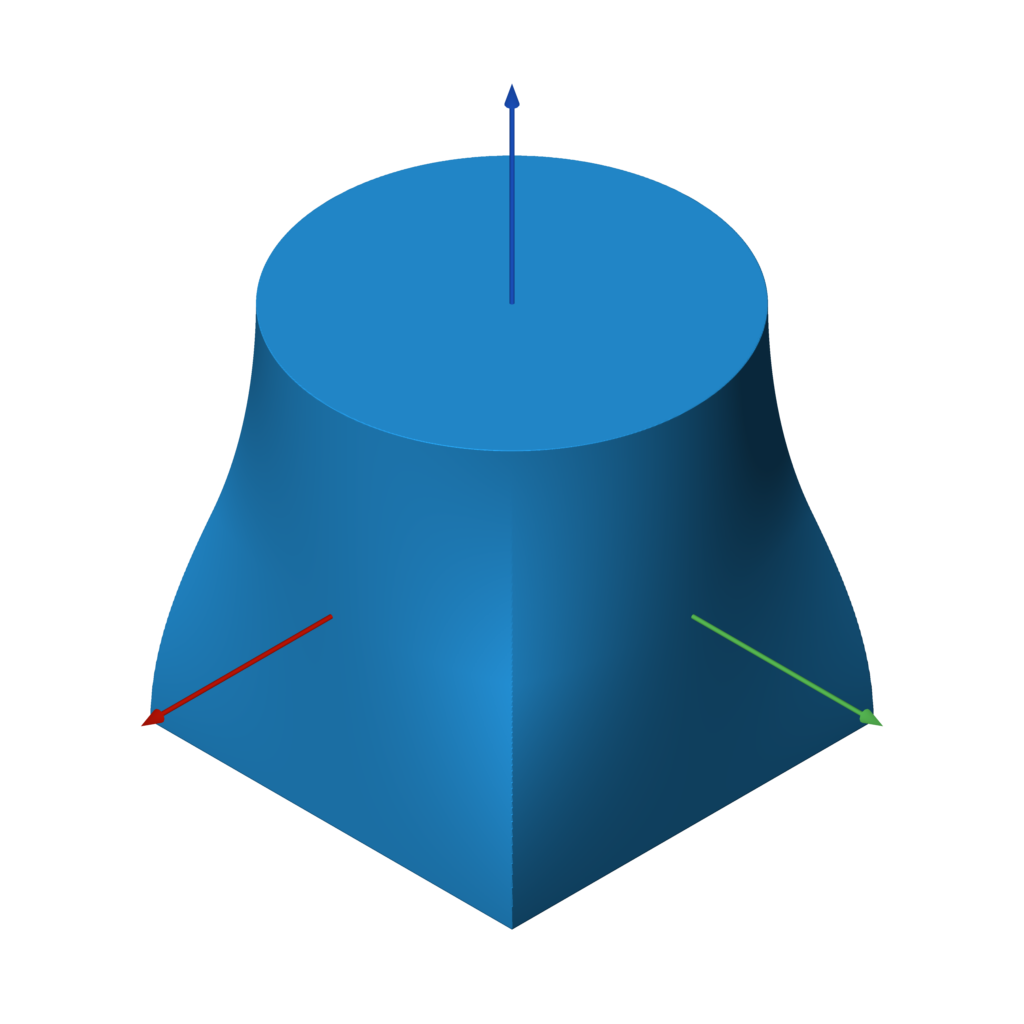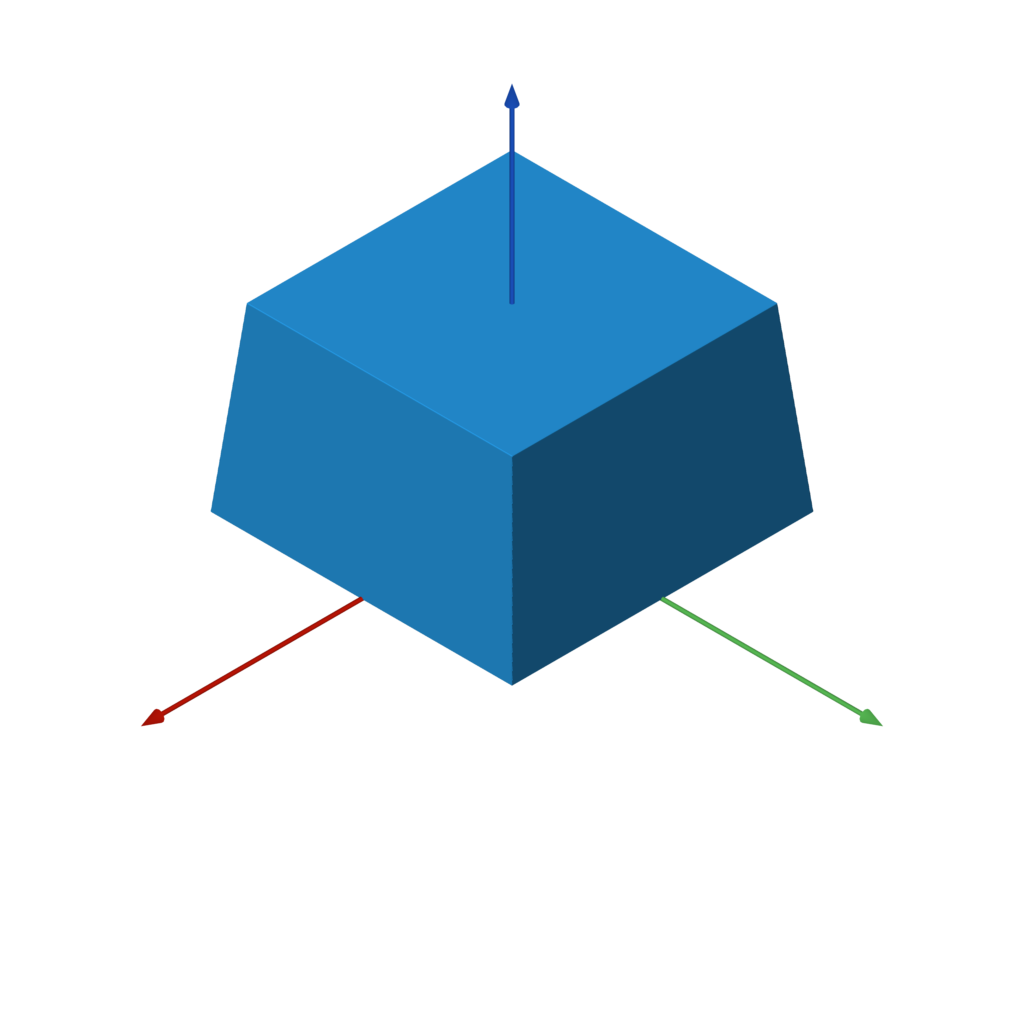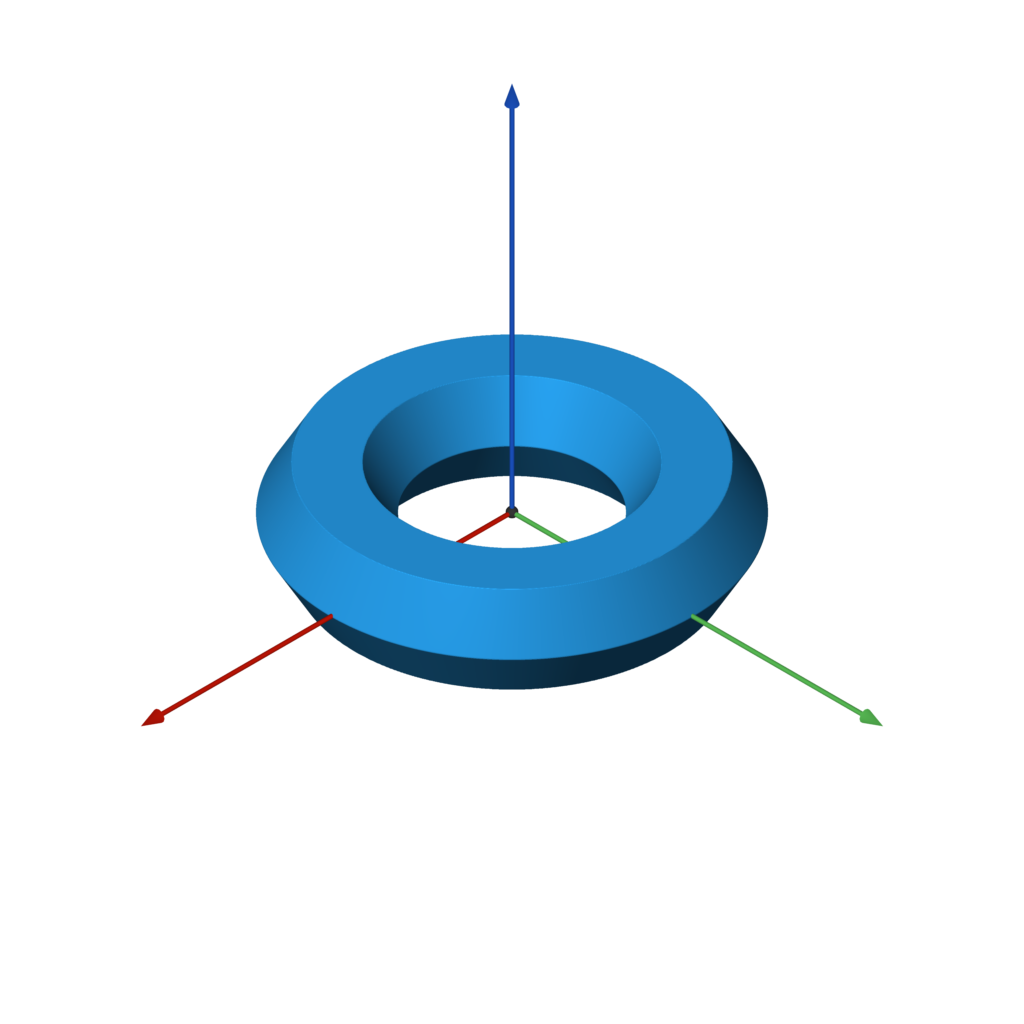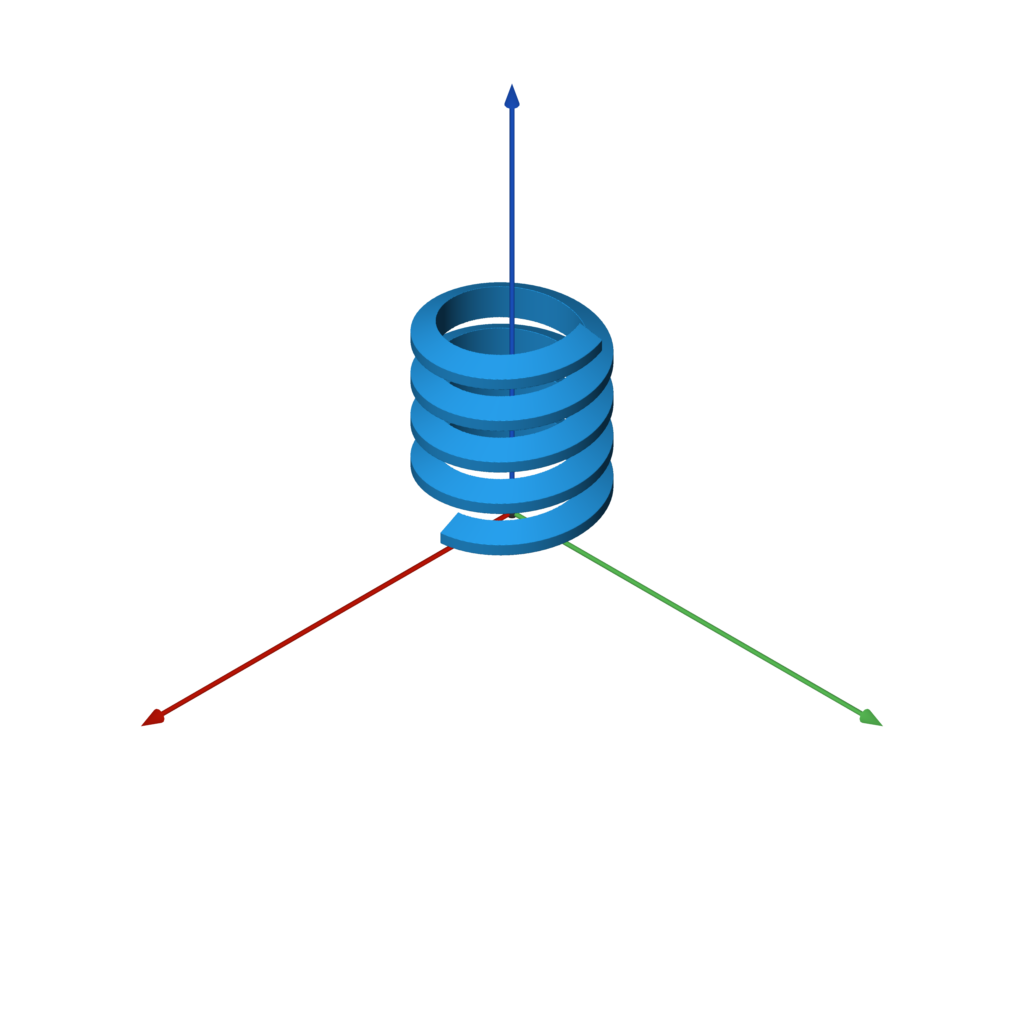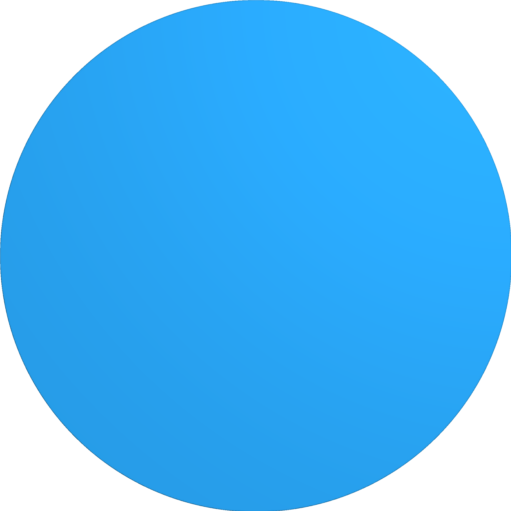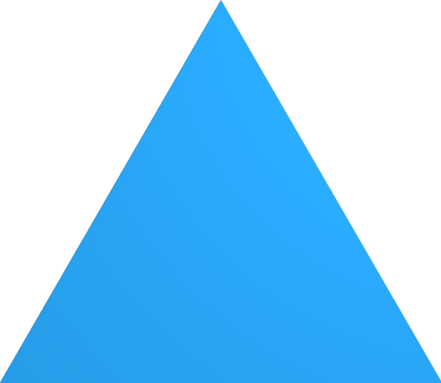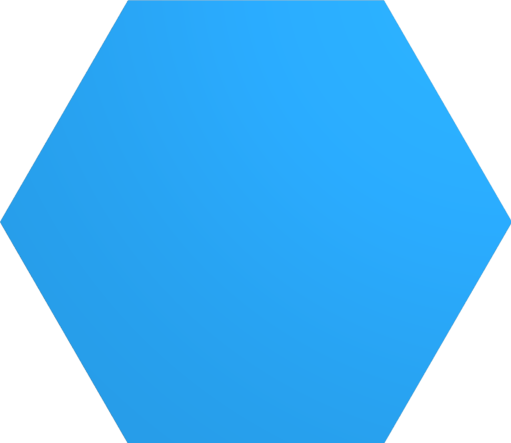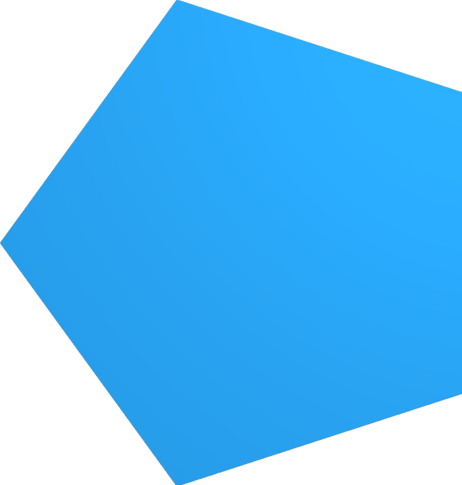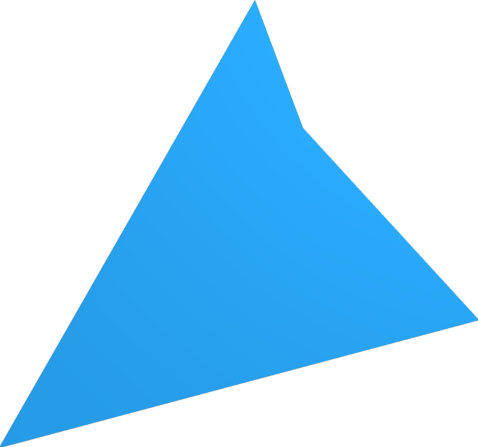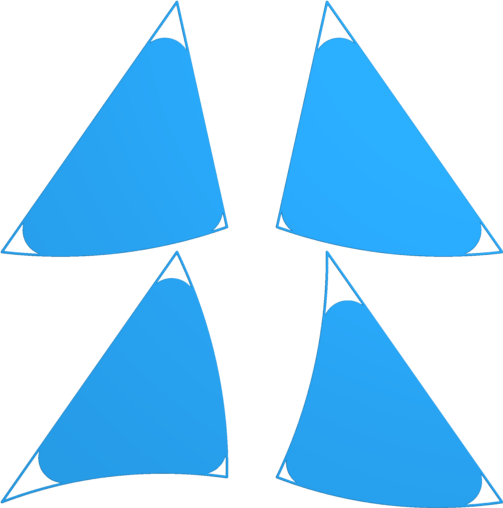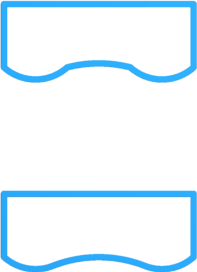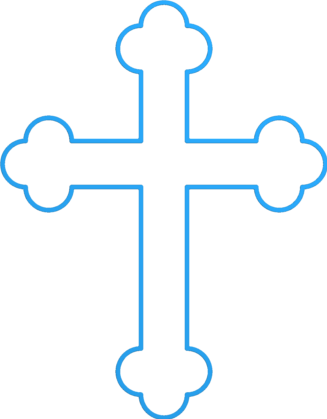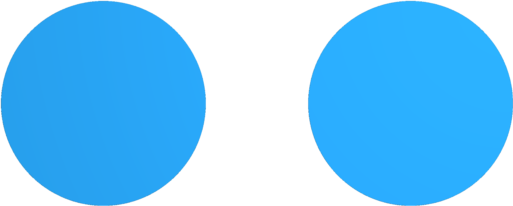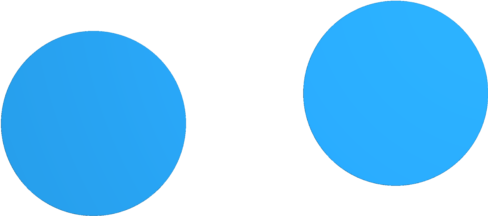Generate 3D meshes based on SDFs (signed distance functions) with a dirt simple Python API.
Special thanks to Inigo Quilez for his excellent documentation on signed distance functions:
Here is a complete example that generates the model shown. This is the canonical Constructive Solid Geometry example. Note the use of operators for union, intersection, and difference.
from sdf import *
f = sphere(1) & box(1.5)
c = cylinder(0.5)
f -= c.orient(X) | c.orient(Y) | c.orient(Z)
f.save('out.stl')Yes, that's really the entire code! You can 3D print that model or use it in a 3D application.
Have a cool example? Submit a PR!
| gearlike.py | knurling.py | blobby.py | weave.py |
|---|---|---|---|
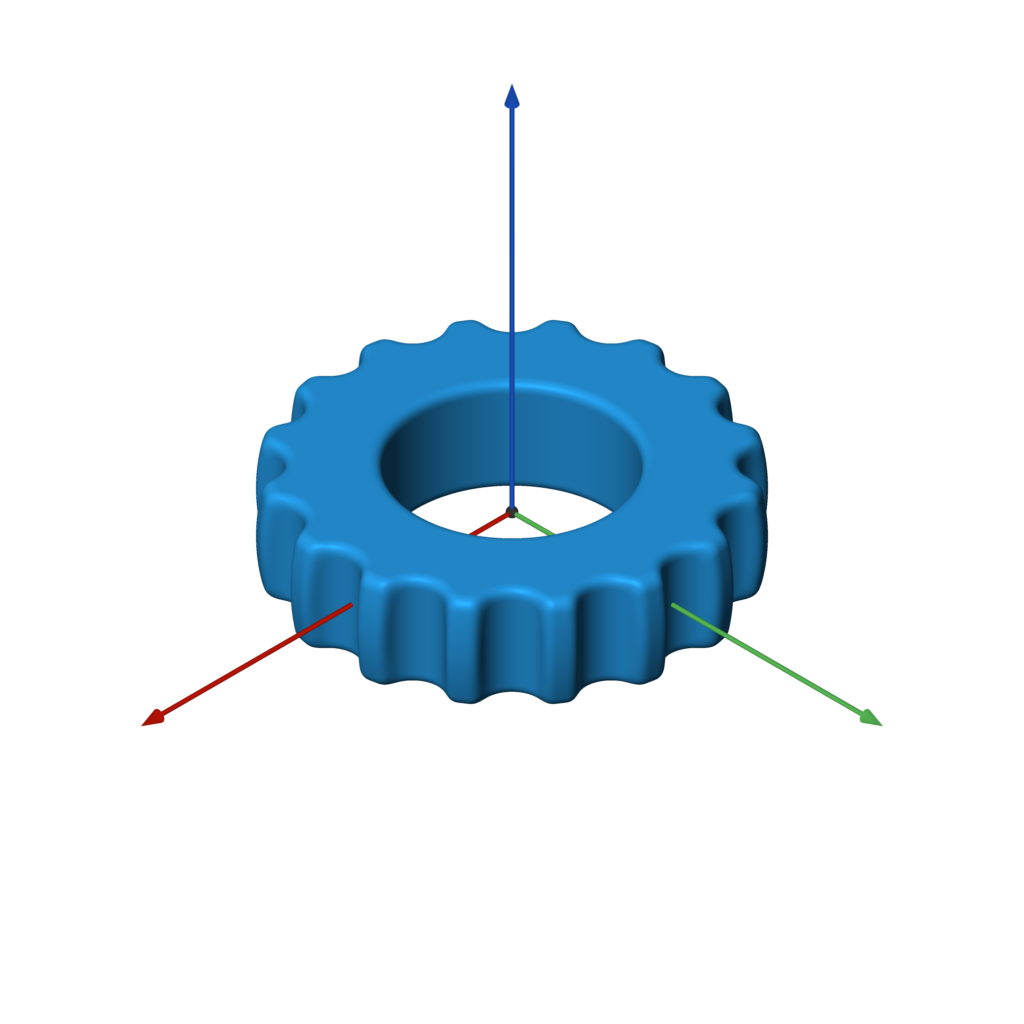 |
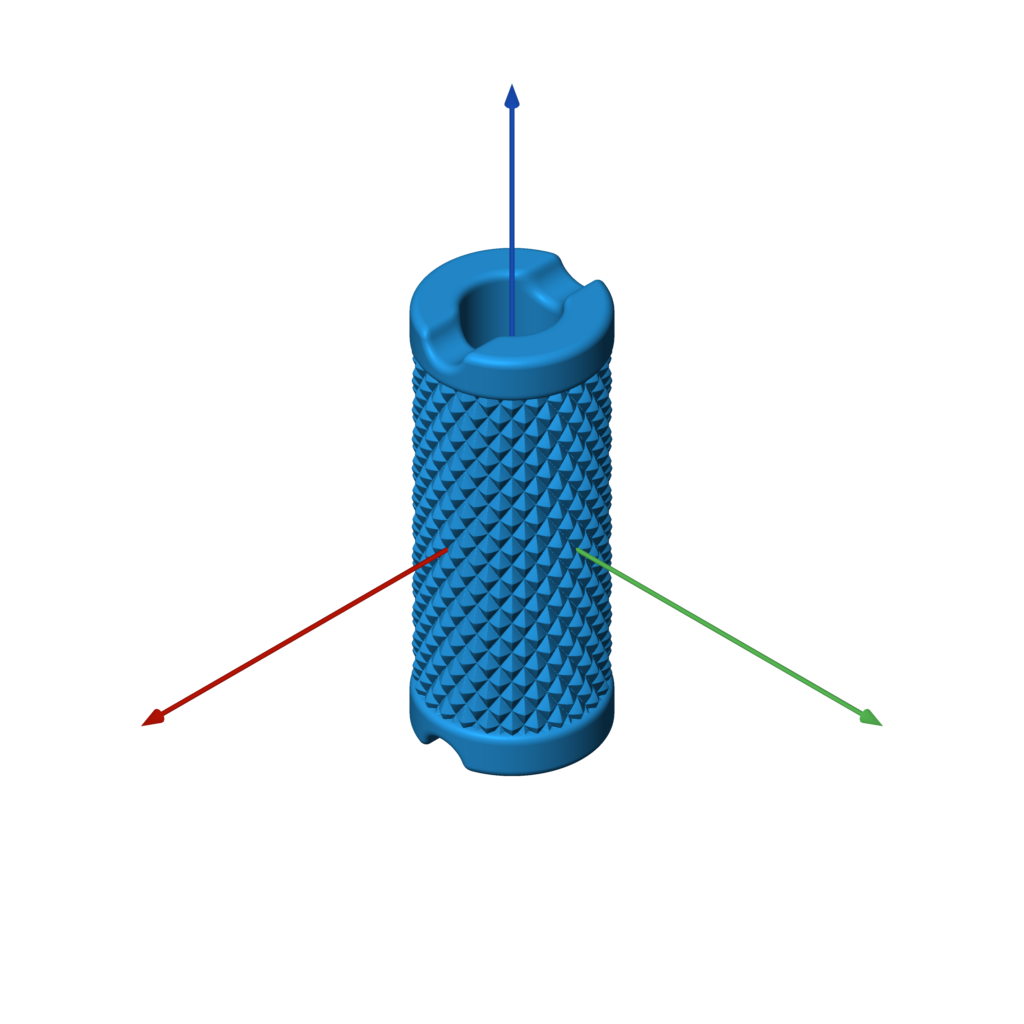 |
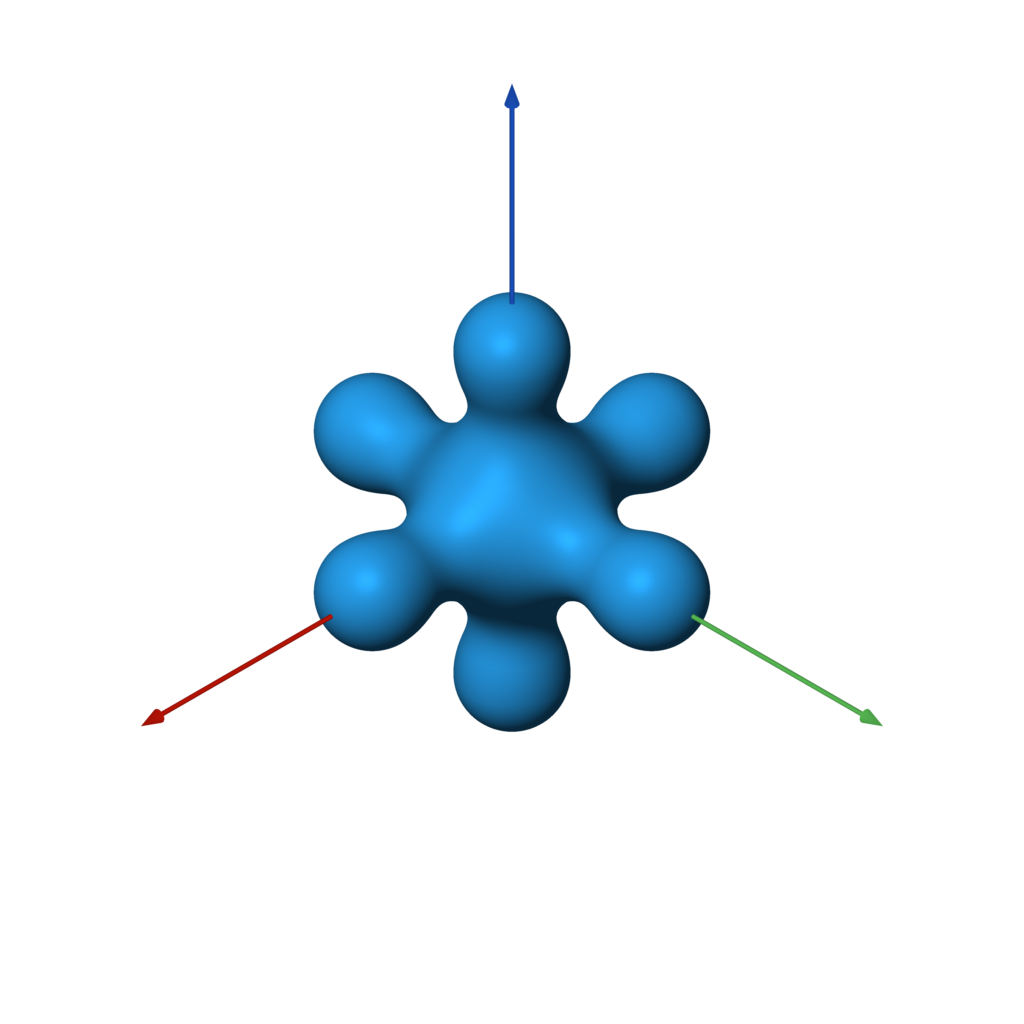 |
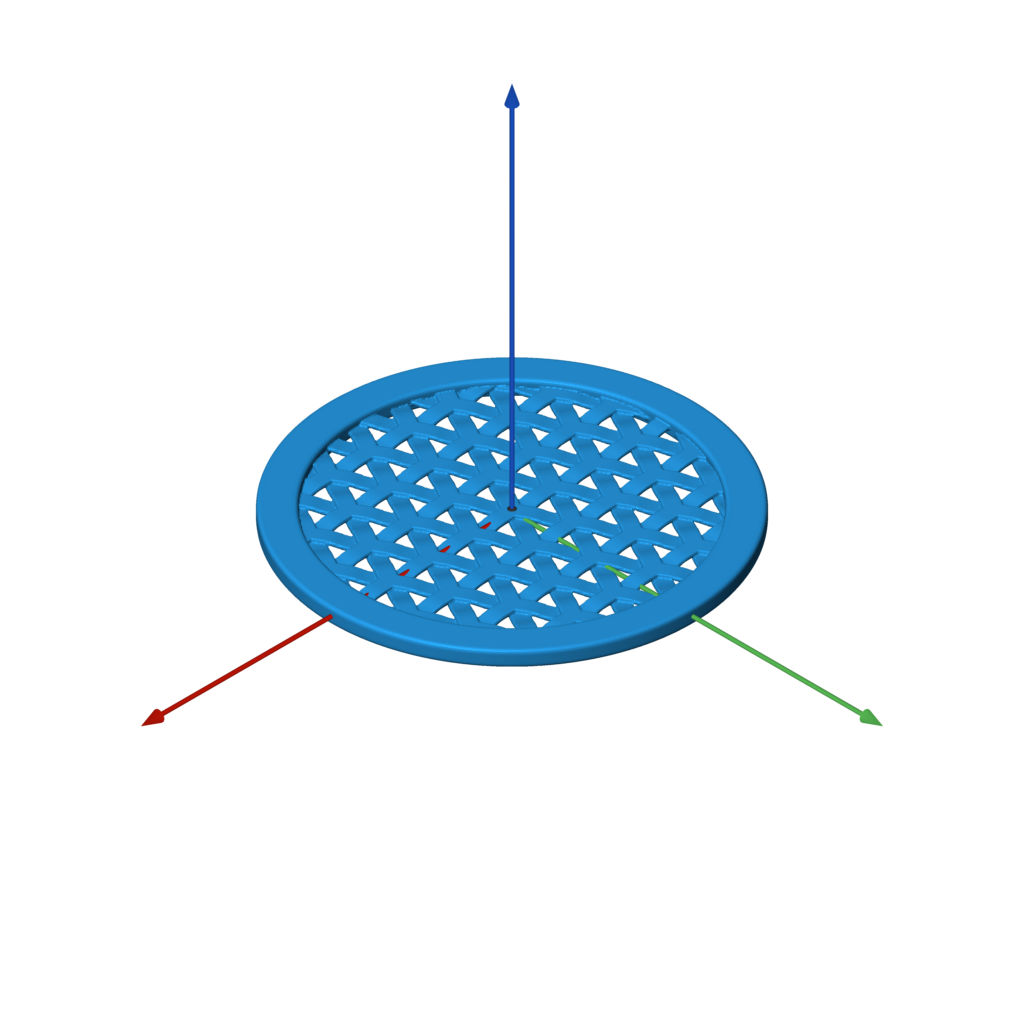 |
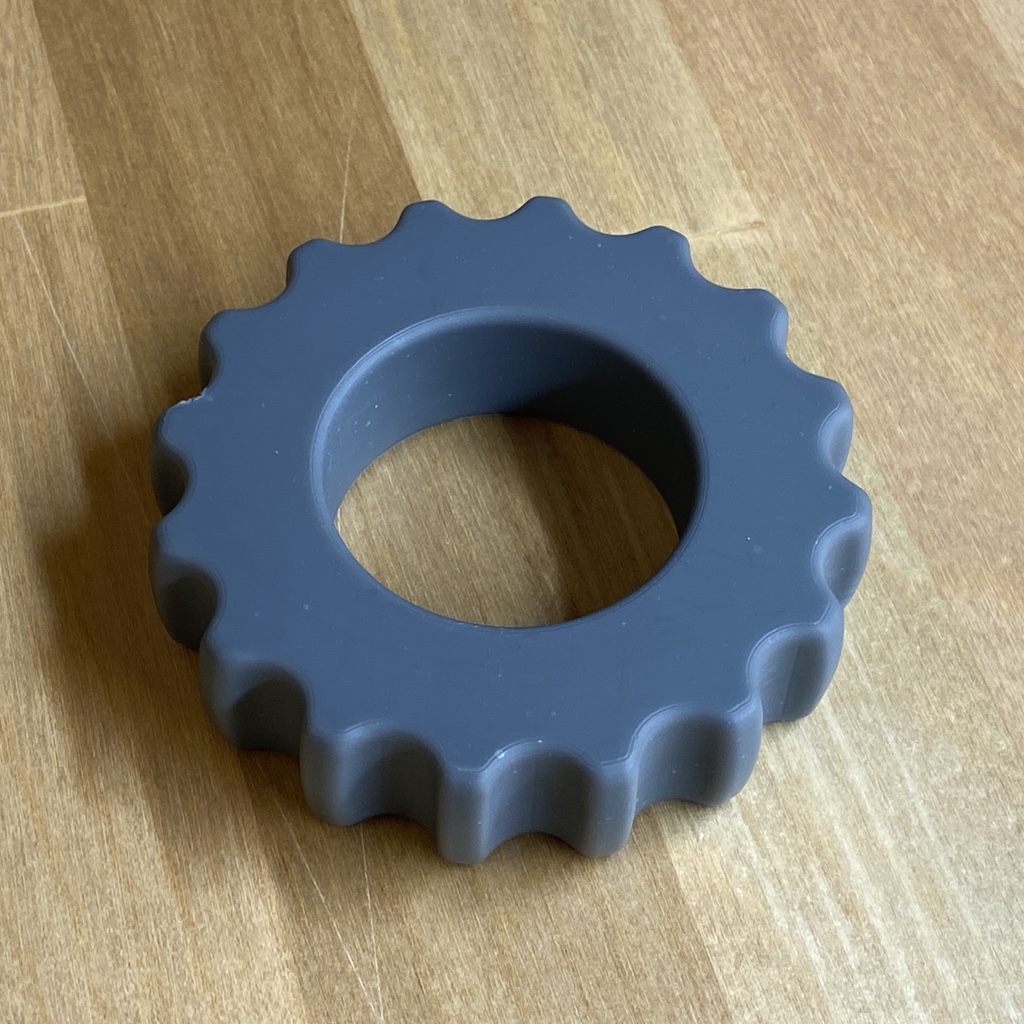 |
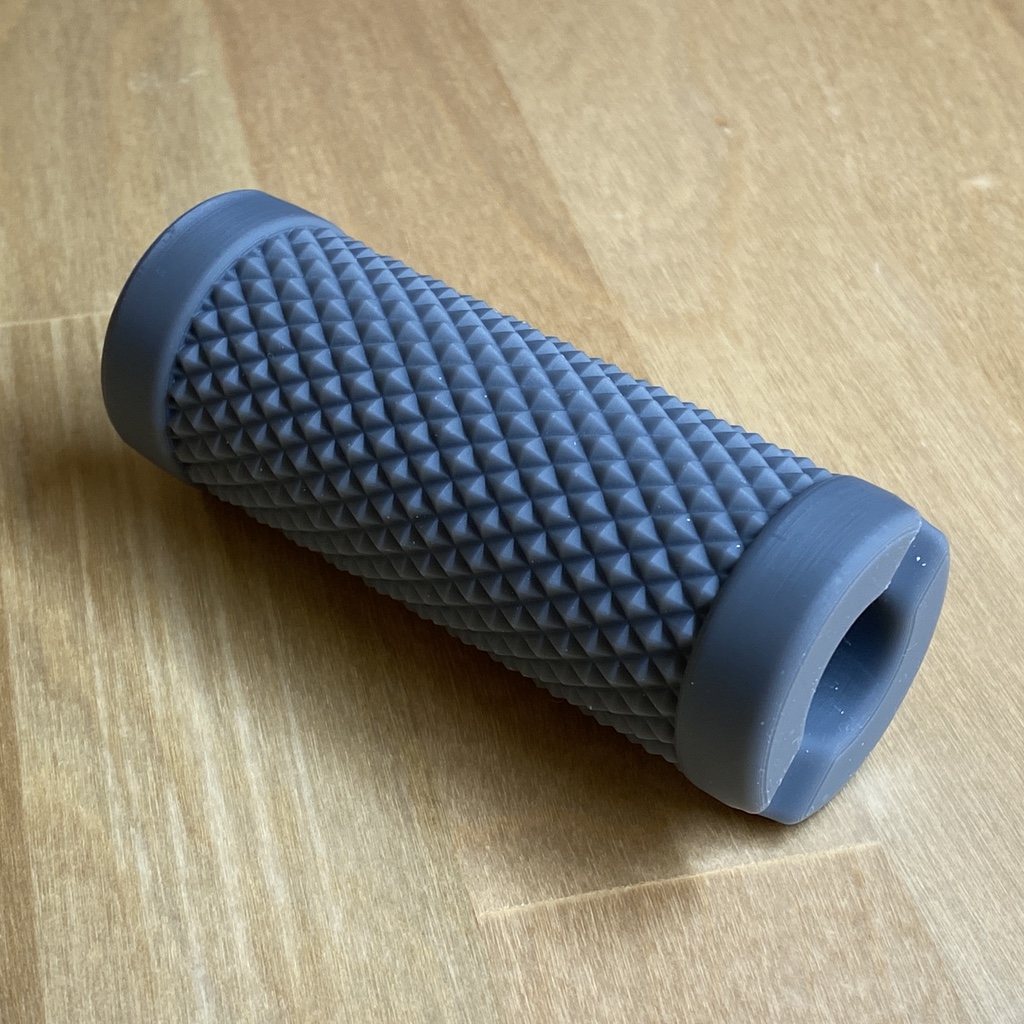 |
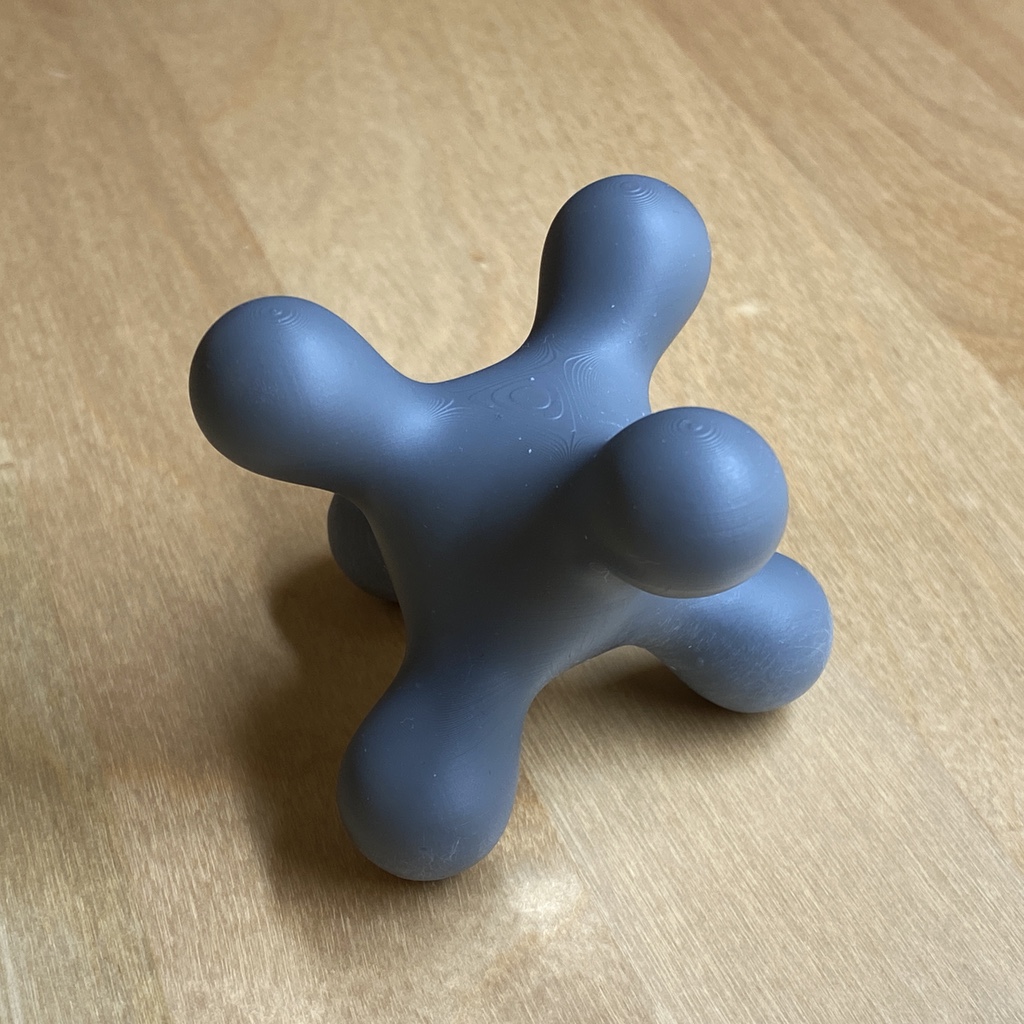 |
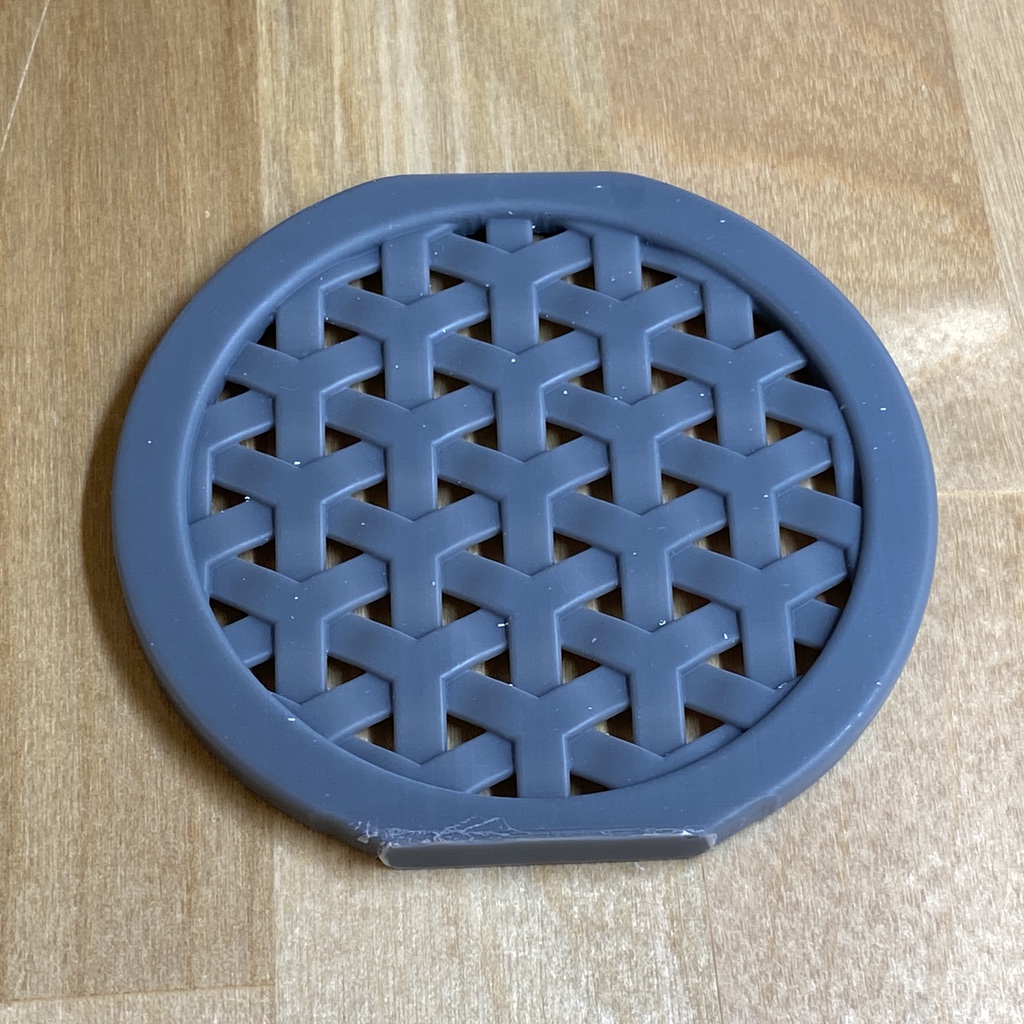 |
More examples!
| pawn.py | steering_wheel.py | spinning_top.py |
|---|---|---|
 |
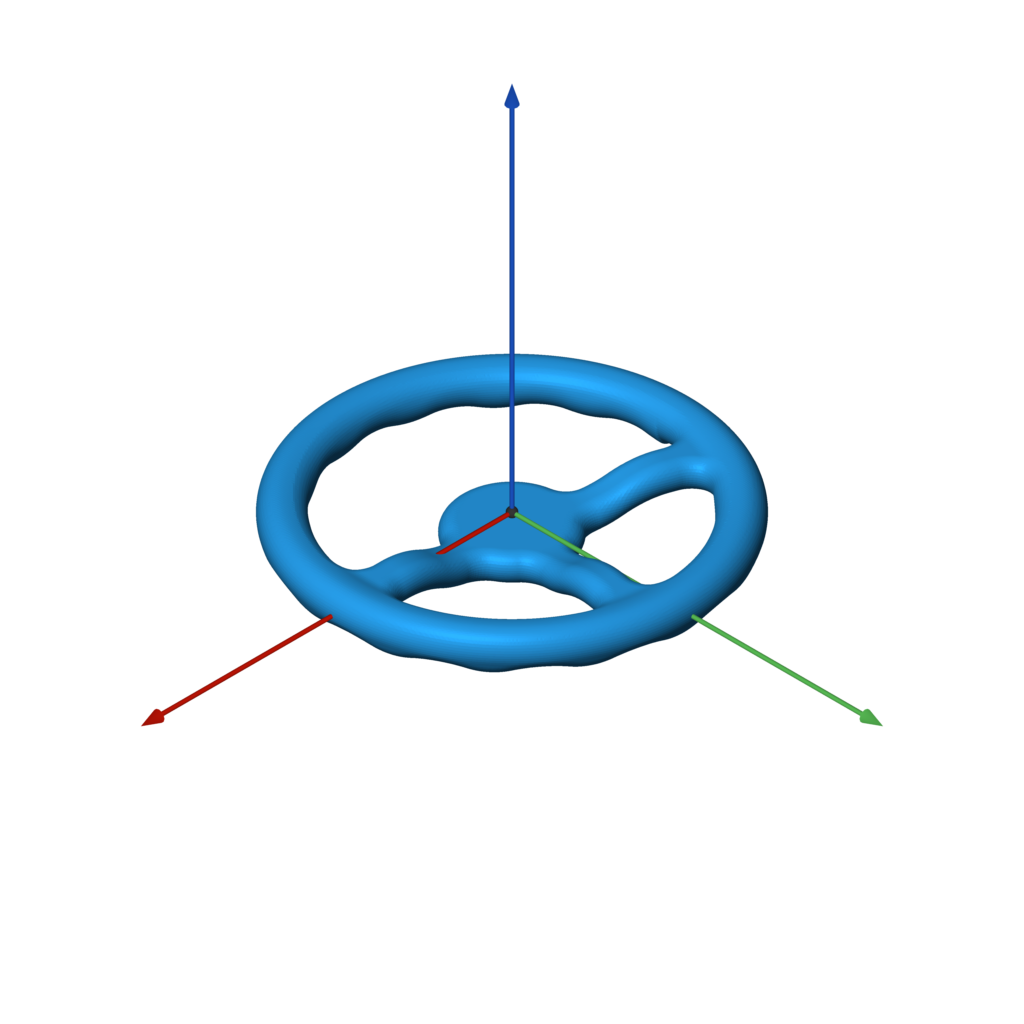 |
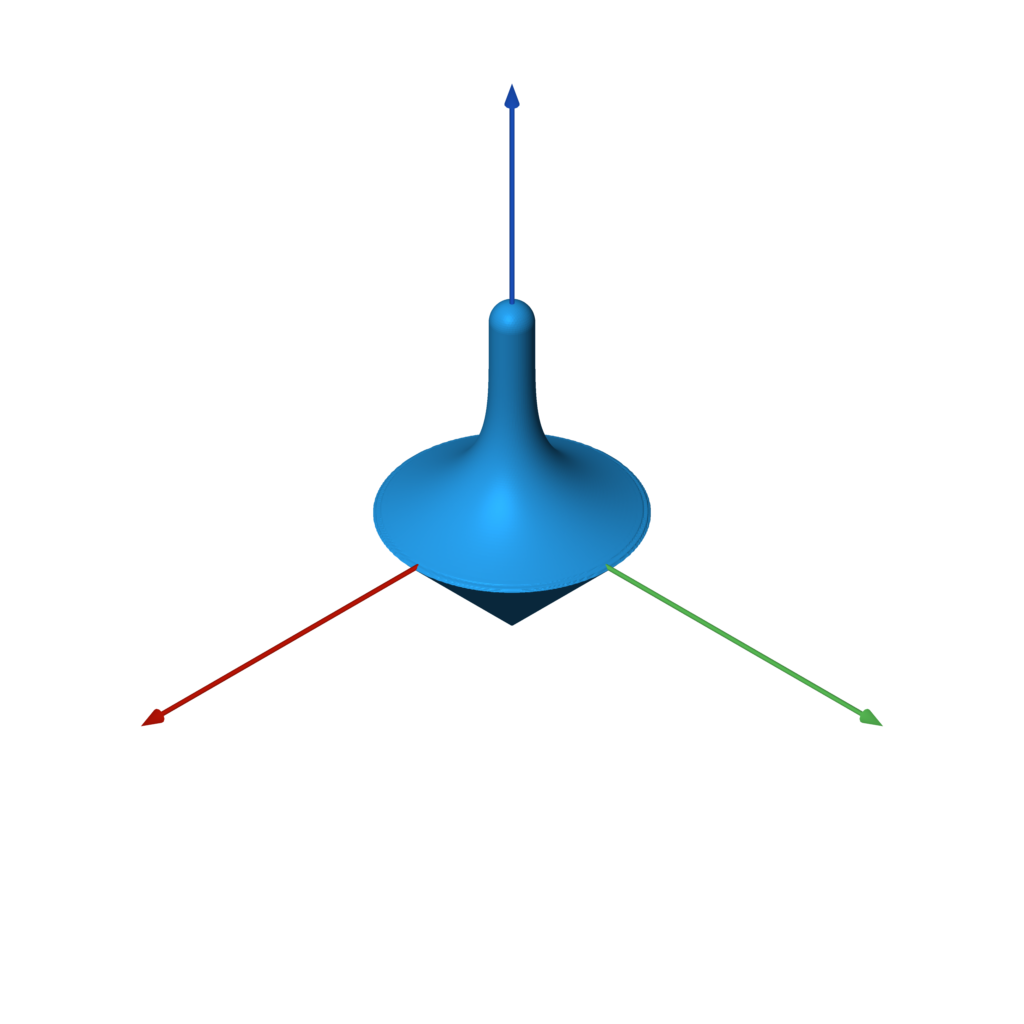 |
Note that the dependencies will be automatically installed by setup.py when following the directions below.
- Python 3
- matplotlib
- meshio
- numpy
- Pillow
- scikit-image
- scipy
Use the commands below to clone the repository and install the sdf library
in a Python virtualenv.
git clone https://github.com/fogleman/sdf.git
cd sdf
virtualenv env
. env/bin/activate
pip install -e .Confirm that it works:
python examples/example.py # should generate a file named out.stlYou can skip the installation if you always run scripts that import sdf
from the root folder.
sdf natively writes binary STL files. For other formats, meshio
is used (based on your output file extension). This adds support for over 20 different 3D file formats,
including OBJ, PLY, VTK, and many more.
Find and install a 3D mesh viewer for your platform, such as MeshLab.
I have developed and use my own cross-platform mesh viewer called meshview (see screenshot). Installation is easy if you have Go and glfw installed:
$ brew install go glfw # on macOS with homebrew
$ go get -u github.com/fogleman/meshview/cmd/meshviewThen you can view any mesh from the command line with:
$ meshview your-mesh.stlSee the meshview README for more complete installation instructions.
On macOS you can just use the built-in Quick Look (press spacebar after selecting the STL file in Finder) in a pinch.
In all of the below examples, f is any 3D SDF, such as:
f = sphere()The bounding box of the SDF is automatically estimated. Inexact SDFs such as non-uniform scaling may cause issues with this process. In that case you can specify the bounds to sample manually:
f.save('out.stl', bounds=((-1, -1, -1), (1, 1, 1)))The resolution of the mesh is also computed automatically. There are two ways
to specify the resolution. You can set the resolution directly with step:
f.save('out.stl', step=0.01)
f.save('out.stl', step=(0.01, 0.02, 0.03)) # non-uniform resolutionOr you can specify approximately how many points to sample:
f.save('out.stl', samples=2**24) # sample about 16M pointsBy default, samples=2**22 is used.
Tip: Use the default resolution while developing your SDF. Then when you're done, crank up the resolution for your final output.
Simplification of the mesh can be accomplished at the same time by using:
f.save('out.stl', samples=2**24, simplify=True)
# to simplify (remove 80%) of the mesh after rendering, use:
f.save('out.stl', samples=2**24, simplify=True, simp_ratio=0.2)
# to change the simplification agressive value use
f.save('out.stl', samples=2**24, simplify=True, simp_agressive=5)or generate once and then simplify afterwards:
points = f.generate()
points = simplify(points)
save_mesh("test_output.stl",points) # save as STL file
#save_mesh("test_output.stp",points) # save as STEP fileBy default, simp_ratio=0.5, simp_agressive=7 is used.
For more information see https://github.com/sp4cerat/Fast-Quadric-Mesh-Simplification
The SDF is sampled in batches. By default the batches have 32**3 = 32768
points each. This batch size can be overridden:
f.save('out.stl', batch_size=64) # instead of 32The code attempts to skip any batches that are far away from the surface of the mesh. Inexact SDFs such as non-uniform scaling may cause issues with this process, resulting in holes in the output mesh (where batches were skipped when they shouldn't have been). To avoid this, you can disable sparse sampling:
f.save('out.stl', sparse=False) # force all batches to be completely sampledThe SDF is sampled in batches using worker threads. By default,
multiprocessing.cpu_count() worker threads are used. This can be overridden:
f.save('out.stl', workers=1) # only use one worker threadYou can of course generate a mesh without writing it to an STL file:
points = f.generate() # takes the same optional arguments as `save`
print(len(points)) # print number of points (3x the number of triangles)
print(points[:3]) # print the vertices of the first triangleIf you want to save an STL after generate, just use:
write_binary_stl(path, points)To read the points from a mesh file use read_mesh(file) and to save use save_mesh(file, points).
The format of the file is determined by the suffix. For a full list of supported formats, refer to
meshio. The additonal STEP file format is only available for saving.
An example of reading a STL file, simplifying it, and then writing it out as a STEP file:
points = read_mesh("my_mesh.stl") # This reads a STL file
points = simplify(points) # Reduce the mesh to about half
save_mesh("my_mesh.stp",points) # Write the mesh out to a STEP fileYou can plot a visualization of a 2D slice of the SDF using matplotlib. This can be useful for debugging purposes.
f.show_slice(z=0)
f.show_slice(z=0, abs=True) # show abs(f)You can specify a slice plane at any X, Y, or Z coordinate. You can also specify the bounds to plot.
Note that matplotlib is only imported if this function is called, so it
isn't strictly required as a dependency.
The code simply uses the Marching Cubes algorithm to generate a mesh from the Signed Distance Function.
This would normally be abysmally slow in Python. However, numpy is used to evaluate the SDF on entire batches of points simultaneously. Furthermore, multiple threads are used to process batches in parallel. The result is surprisingly fast (for marching cubes). Meshes of adequate detail can still be quite large in terms of number of triangles.
The core "engine" of the sdf library is very small and can be found in
mesh.py.
In short, there is nothing algorithmically revolutionary here. The goal is to provide a simple, fun, and easy-to-use API for generating 3D models in our favorite language Python.
- sdf/d2.py: 2D signed distance functions
- sdf/d3.py: 3D signed distance functions
- sdf/dn.py: Dimension-agnostic signed distance functions
- sdf/ease.py: Easing functions that operate on numpy arrays. Some SDFs take an easing function as a parameter.
- sdf/mesh.py: The core mesh-generation engine. Also includes code for estimating the bounding box of an SDF and for plotting a 2D slice of an SDF with matplotlib.
- sdf/progress.py: A console progress bar.
- sdf/stl.py: Code for writing a binary STL file.
- sdf/text.py: Generate 2D SDFs for text (which can then be extruded)
- sdf/util.py: Utility constants and functions.
It is reasonable to write your own SDFs beyond those provided by the built-in library. Browse the SDF implementations to understand how they are implemented. Here are some simple examples:
@sdf3
def sphere(radius=1, center=ORIGIN):
def f(p):
return np.linalg.norm(p - center, axis=1) - radius
return fAn SDF is simply a function that takes a numpy array of points with shape (N, 3)
for 3D SDFs or shape (N, 2) for 2D SDFs and returns the signed distance for each
of those points as an array of shape (N, 1). They are wrapped with the
@sdf3 decorator (or @sdf2 for 2D SDFs) which make boolean operators work,
add the save method, add the operators like translate, etc.
@op3
def translate(other, offset):
def f(p):
return other(p - offset)
return fAn SDF that operates on another SDF (like the above translate) should use
the @op3 decorator instead. This will register the function such that SDFs
can be chained together like:
f = sphere(1).translate((1, 2, 3))Instead of what would otherwise be required:
f = translate(sphere(1), (1, 2, 3))Remember, this is Python, so it's fully programmable. You can and should split up your model into parameterized sub-components, for example. You can use for loops and conditionals wherever applicable. The sky is the limit!
See the customizable box example for some starting ideas.
Draw a sphere with the radius centered around center, by default this is the origin (0,0,0).
sphere(radius=1, center=ORIGIN)
f = sphere() # unit sphere
f = sphere(2) # specify radius
f = sphere(1, (1, 2, 3)) # translated sphereDraw a 3D box with sides specified centered around center, by default this is the origin (0,0,0).
box(size=1, center=ORIGIN, a=None, b=None)
f = box(1) # all side lengths = 1, like a cube
f = box((1, 2, 3)) # different side lengths
f = box(a=(-1, -1, -1), b=(3, 4, 5)) # specified by boundsDraw a 3D rounded box with sides specified centered around center, by default this is the origin (0,0,0). The radius of curvature is specified by radius.
rounded_box(size, radius, center=ORIGIN)
f = rounded_box((1, 2, 3), 0.25)Draw a 3D box with round wires (diameter is specified by thickness) and centered around center, by default this is the origin (0,0,0). The radius of curvature is specified by radius.
wireframe_box(size, thickness)
f = wireframe_box((1, 2, 3), 0.05)torus is like a doughnut shape, like a circle with radius, r2, rotated around the Z axis at a radius, r1, from the center.
torus(r1, r2)
f = torus(1, 0.25)capsule is a cylinder with rounded ends extending from -Z to Z and having the radius, radius.
capsule(a, b, radius)
f = capsule(-Z, Z, 0.5)capped_cylinder is a flat ended cylinder extending from a to b, both 3D vectors, and having the radius, radius.
capped_cylinder(a, b, radius)
# note: Z = np.array((0, 0, 1))
f = capped_cylinder(-Z, Z, 0.5)rounded_cylinder is a flat ended cylinder with curved edges extending from a to b, scalers along the Z axis, and having the radius, ra, and the edges having a radius of rb.
rounded_cylinder(ra, rb, h)
f = rounded_cylinder(0.5, 0.1, 2)capped_cone is a flat ended cone extending from a to b, both 3D vectors, and having the radii, ra and rb.
capped_cone(a, b, ra, rb)
# note: Z = np.array((0, 0, 1))
f = capped_cone(-Z, Z, 1, 0.5)rounded_cone is a hemisphere ended cone extending along the Z axis from 0 to h, and having the radii, r1 and r2.
rounded_cone(r1, r2, h)
f = rounded_cone(0.75, 0.25, 2)ellipsoid is like a distored sphere centered at the origin, size is specified by a 3D array of scalars.
ellipsoid(size)
f = ellipsoid((1, 2, 3))pyramid is the simplest 3D flat sided object, consisting of one side being a
triangle at the base and 3 more equal sized triangles matching those edges and
meeting at the point h along the Z axis.
pyramid(h)
f = pyramid(1)tetrahedron(r)
f = tetrahedron(1)octahedron(r)
f = octahedron(1)dodecahedron(r)
f = dodecahedron(1)icosahedron(r)
f = icosahedron(1)The following SDFs extend to infinity in some or all axes. They can only effectively be used in combination with other shapes, as shown in the examples below.
line(normal=UP, point=ORIGIN)
line is an infinite cut line, with the positive side being inside and the
negative side being outside.
f = (circle() & line()).extrude(0.1)crop(x0=None, y0=None, x1=None, y1=None, k=None)
crop is useful for cutting a shape on one or more axis-aligned planes. Note
that one can accomplish the same affect by four line cuts with axis normals and
points defined on the edges.
f = (circle() & crop(y0=-0.5, y1=0.5, x0=0)).extrude(0.1)The following SDFs extend to infinity in some or all axes. They can only effectively be used in combination with other shapes, as shown in the examples below.
plane(normal=UP, point=ORIGIN)
plane is an infinite plane, with the positive side being inside and the
negative side being outside.
f = sphere() & plane()slab(x0=None, y0=None, z0=None, x1=None, y1=None, z1=None, k=None)
slab is useful for cutting a shape on one or more axis-aligned planes. Note
that the same effect can be accomplished by using multiple planes cutting with
a normal starting at points on the cut plane.
f = sphere() & slab(z0=-0.5, z1=0.5, x0=0)cylinder(radius)
cylinder is an infinite cylinder along the Z axis. This is useful for
cutting a hole in an object (- operation) or widdling down an object
so it fits within a cylinder (& operation).
f = sphere() - cylinder(0.5)Yes, even text is supported!
text(font_name, text, width=None, height=None, pixels=PIXELS, points=512)
FONT = 'Arial'
TEXT = 'Hello, world!'
w, h = measure_text(FONT, TEXT)
f = rounded_box((w + 1, h + 1, 0.2), 0.1)
f -= text(FONT, TEXT).extrude(0.2).k(0.05)Note: PIL.ImageFont,
which is used to load fonts, does not search for the font by name on all operating systems.
For example, on Ubuntu the full path to the font has to be provided.
(e.g. /usr/share/fonts/truetype/freefont/FreeMono.ttf)
Image masks can be extruded and incorporated into your 3D model.
image(path_or_array, width=None, height=None, pixels=PIXELS)
IMAGE = 'examples/butterfly.png'
w, h = measure_image(IMAGE)
f = rounded_box((w * 1.1, h * 1.1, 0.1), 0.05)
f |= image(IMAGE).extrude(1) & slab(z0=0, z1=0.075)translate(other, offset)
f = sphere().translate((0, 0, 2))Scale and figure larger or smaller with factor. Unity, 1.0, will leave the
object the same and smaller numbers will shrink, such as 0.5 which scales to
half the size, and 2.0 which scales to double the size.
scale(other, factor)
Note that non-uniform scaling is an inexact SDF.
f = sphere().scale(2)
f = sphere().scale((1, 2, 3)) # non-uniform scalingGiven an angle and rotation vector, rotate the figure by angle in radians
(for rotate) or degrees (for rotateD), around the vector axis. So a rotation
around Z will translate points around the X-Y plane and leave the Z values the
same.
rotate(other, angle, vector=Z)
rotateD(other, angle_in_degrees, vector=Z)
f = capped_cylinder(-Z, Z, 0.5).rotate(pi / 4, X)
f = capped_cylinder(-Z, Z, 0.5).rotateD(45, X)This function reflects the 3d image over the plane specified by the vector.
For example, using Z will reflect across the Z plane mapping every positive
Z point to it's negative counterpart and vice versa.
mirror(other, vector, center=ORIGIN)
f = circle(3).taper_extrude(3,1).translate((0,0,-3))
# draw it again upside down
f |= circle(3).taper_extrude(3,1).translate((0,0,-3)).mirror([0,0,1])mirror_copy(other, vector, center=ORIGIN)
f = circle(3).taper_extrude(3,1).translate((0,0,-3)).mirror_copy([0,0,1])orient(other, axis)
orient rotates the shape such that whatever was pointing in the +Z direction
is now pointing in the specified direction.
c = capped_cylinder(-Z, Z, 0.25)
f = c.orient(X) | c.orient(Y) | c.orient(Z)The following primitives a and b are used in all of the following
boolean operations.
a = box((3, 3, 0.5))
b = sphere()The named versions (union, difference, intersection) can all take
one or more SDFs as input. They all take an optional k parameter to define the amount
of smoothing to apply. When using operators (|, -, &) the smoothing can
still be applied via the .k(...) function.
f = a | b
f = union(a, b) # equivalentf = a - b
f = difference(a, b) # equivalentf = a & b
f = intersection(a, b) # equivalentf = a | b.k(0.25)
f = union(a, b, k=0.25) # equivalentf = a - b.k(0.25)
f = difference(a, b, k=0.25) # equivalentf = a & b.k(0.25)
f = intersection(a, b, k=0.25) # equivalentrepeat(other, spacing, count=None, padding=0)
repeat can repeat the underlying SDF infinitely or a finite number of times.
If finite, the number of repetitions must be odd, because the count specifies
the number of copies to make on each side of the origin. If the repeated
elements overlap or come close together, you may need to specify a padding
greater than zero to compute a correct SDF.
f = sphere().repeat(3, (1, 1, 0))circular_array(other, count, offset)
circular_array makes count copies of the underlying SDF, arranged in a
circle around the Z axis. offset specifies how far to translate the shape
in X before arraying it. The underlying SDF is only evaluated twice (instead
of count times), so this is more performant than instantiating count copies
of a shape.
f = capped_cylinder(-Z, Z, 0.5).circular_array(8, 4)Some of the functions demonstrated below use an example as a starting point:
f = sphere(1) & box(1.5)
c = cylinder(0.5)
f -= c.orient(X) | c.orient(Y) | c.orient(Z)
example = fBlending of two objects using the scalar distance function between values of two objects with scalar k.
blend(a, *bs, k=0.5)
f = sphere().blend(box())Decrease the scalar distance value by radius, r, making the object edges dilate, or appear to inflate.
dilate(other, r)
f = example.dilate(0.1)Increase the scalar distance value by radius, r, making the object edges erode, or appear to deflate.
erode(other, r)
f = example.erode(0.1)Create a shell at every boundary, where the scalar distance value crosses positive and negative values. The thickness of the shell created on the edge is defined by thickness.
shell(other, thickness)
f = sphere().shell(0.05) & plane(-Z)elongate(other, size)
f = example.elongate((0.25, 0.5, 0.75))twist(other, k)
f = box().twist(pi / 2)bend(other, k)
f = box().bend(1)bend_linear(other, p0, p1, v, e=ease.linear)
f = capsule(-Z * 2, Z * 2, 0.25).bend_linear(-Z, Z, X, ease.in_out_quad)bend_radial(other, r0, r1, dz, e=ease.linear)
f = box((5, 5, 0.25)).bend_radial(1, 2, -1, ease.in_out_quad)transition_linear(f0, f1, p0=-Z, p1=Z, e=ease.linear)
f = box().transition_linear(sphere(), e=ease.in_out_quad)transition_radial(f0, f1, r0=0, r1=1, e=ease.linear)
f = box().transition_radial(sphere(), e=ease.in_out_quad)This function will take an XYZ cartesian coordinate space and convert into polar coordinates where the X axis is mapped into the radial axis, Y axis into the angular, and Z is left alone.
wrap_around(other, x0, x1, r=None, e=ease.linear)
FONT = 'Arial'
TEXT = ' wrap_around ' * 3
w, h = measure_text(FONT, TEXT)
f = text(FONT, TEXT).extrude(0.1).orient(Y).wrap_around(-w / 2, w / 2)extrude(other, h)
f = hexagon(1).extrude(1)Extrude a 2D and add round edges on border.
rounded_extrude(other, h, radius=0)
f = hexagon(10).rounded_extrude(5, radius=2)Note: when using a negative value, the rounding will go in the opposite direction.
f = hexagon(10).rounded_extrude(5, radius=-2)Extrude two 2D images and add round edges on border and at the intersection weld the joints.
rounded_extrude_stack(other_bottom, other_top, height_bottom, height_top, radius)
To increase tensile strength, sometimes it is useful to add more material at joints, so increasing the weld_radius will add more fill.
rounded_extrude_stack(other_bottom, other_top, height_bottom, height_top, radius, weld_radius)
f = rounded_extrude_stack(rectangle([16,6]),rectangle([6,16]), 5, 7, radius=1)
# to alter the weld radius between the two objects:
f = rounded_extrude_stack(rectangle([16,6]),rectangle([6,16]), 5, 7, radius=1, weld_radius=2):extrude_to takes two different 2D objects and blends them together by an ease
operator, by default it is linear, so as to make a smooth transition between
the two objects.
extrude_to(a, b, h, e=ease.linear)
f = rectangle(2).extrude_to(circle(1), 2, ease.in_out_quad)In taper_extrude, slope is the amount of contracting per unit Z over the
height of the extrude. A negative value will cause the image to expand and
corners will become a larger rounded edge.
taper_extrude(other, height, slope=0, e=ease.linear)
f = rectangle(10).taper_extrude(6, slope=0.1)revolve takes a 2D object and rotates it around the Z axis. Offset is how
far the center point is moved away from the origin on the XY plane.
revolve(other, offset=0)
f = hexagon(1).revolve(3)helix_revolve will take a 2D object and rotate it around the Z axis while
linearly moving in a helix toward positive Z. A practical use for this is to
create threads. By negating pitch, one can reverse the thread, changing the
rotation from right-handed to left-handed.
helix_revolve(other, offset=0, pitch=1, rotations=1)
f = polygon([[3,0],[4,.5],[4,1],[3,1.5]]).helix_revolve(pitch=2, rotations=4.3)slice(other)
f = example.translate((0, 0, 0.55)).slice().extrude(0.1)Note: The examples 2D functions below are called and then extruded to show how to convert a 2D to a 3D.
circle(radius=1, center=ORIGIN)
f = circle(2).extrude(0.1)rectangle(size=1, center=ORIGIN, a=None, b=None)
f = rectangle([2,1]).extrude(0.1)
# or you can specify the corners:
f = rectangle(a=[-2,-1],b=[2,1]).extrude(0.1)rounded_rectangle(size=1, radius=0.1, center=ORIGIN, a=None, b=None)
f = rounded_rectangle([2,1],0.2).extrude(0.1)
# or you can specify the corners:
f = rectangle(a=[-2,-1],b=[2,1],radius=0.2).extrude(0.1)equilateral_triangle(r, center=ORIGIN)
f = equilateral_triangle(3).extrude(0.1)hexagon(r)
f = hexagon(2).extrude(0.1)equilateral_polygon(n, r)
equilateral_polygon makes a shape with equal sides, for example n=3 is a
triangle, n=4 is square, n=5 is a pentagon, and so forth. Note: The right edge
will always be vertical and the radius is the distance to the center of a flat face.
f = equilateral_polygon(5,10).extrude(0.1)rounded_x(w, r)
f = rounded_x(10,2).extrude(0.1)rounded_cog(outer_r, cog_r, num)
f = rounded_cog(38, 6, 14).extrude(0.1)polygon(points)
f = polygon([[-16,-16],[14,-8],[3,4],[0,12]]).extrude(0.1)The points provided to the curve polygon are in the form of [x,y,curve_radius] where a curve_radius value of negative will create an arc in the left hand rotation and positive in the right hand rotation. A curve_radius of 0 implies a straight line.
rounded_polygon(points_with_curve)
f = rounded_polygon([[-2,0,0],[0,2,-2**0.5],[2,0,-2**0.5],[0,-2,0]]).extrude(0.1)This function will change When matching three curves, concave-convex-concave or convex-concave-convex, this function will move the points along the outer curves in order to match the center curve exactly.
round_polygon_corners(points_with_curve, radius)
round_polygon_corners(points_with_curve, [radii...], [index_of_vertex...])
pts1 = [[10,0,0],[1,1,-20],[3,10,0]]
pts2 = [[-10,0,0],[-1,1,20],[-3,10,0]]
pts3 = [[10,-10,0],[1,-9,-18],[3,0,20]]
pts4 = [[-10,-10,0],[-1,-9,-18],[-3,0,20]]
f = rounded_polygon(pts1).shell(0.1).extrude(0.1)
f |= rounded_polygon(pts2).shell(0.1).extrude(0.1)
f |= rounded_polygon(pts3).shell(0.1).extrude(0.1)
f |= rounded_polygon(pts4).shell(0.1).extrude(0.1)
rpts1 = round_polygon_corners(pts1,1)
rpts2 = round_polygon_corners(pts2,1)
rpts3 = round_polygon_corners(pts3,1)
rpts4 = round_polygon_corners(pts4,1)
f |= rounded_polygon(rpts1).extrude(0.1)
f |= rounded_polygon(rpts2).extrude(0.1)
f |= rounded_polygon(rpts3).extrude(0.1)
f |= rounded_polygon(rpts4).extrude(0.1)When matching three curves, concave-convex-concave or convex-concave-convex, this function will move the points along the outer curves in order to match the center curve exactly.
round_polygon_smooth_ends(index_of_side_to_modify)
pts = [[3,0,0],[2,0,-0.75],[1,0,2],[0,0,-0.75],[0,1,0],[3,1,0]]
f = rounded_polygon(pts).translate((0,3)).shell(0.1).extrude(0.1)
rpts = round_polygon_smooth_ends(pts,[1])
f |= rounded_polygon(rpts).shell(0.1).extrude(0.1)edge(width)
f = rounded_polygon([
[-4,-1,0],[-6,-1,-1],[-6,1,-1], [-4,1,-1], [-1,1,0], # Left
[-1,4,0], [-1,6,-1], [1,6,-1], [1,4,-1], [1,1,0], # Top
[4,1,0], [6,1,-1], [6,-1,-1], [4,-1,-1], [1,-1,0], # Right
[1,-8,0], [1,-10,-1],[-1,-10,-1],[-1,-8,-1],[-1,-1,0] # Bottom
]).edge(0.1).extrude(0.1)mirror(other, axis=Y, center=ORIGIN)
s = circle(2).translate((3,3))
# draw another on the side, mirrored over the negative X
s |= circle(2).translate((3,3)).mirror([1,0])
f = s.extrude(0.1)
mirror_copy(other, axis=Y, center=ORIGIN)
s = circle(2).translate((3,3)).mirror_copy([1, 0.1])
f = s.extrude(0.1)Standard math routines provided by Python are available, and additional functions available are:
arc_sinD(slope)
arc_cosD(slope)
arc_tanD(slope)
arc_tan2D(y,x)
Returns an angle in degrees.
sinD(ang)
cosD(ang)
tanD(ang)
Takes degrees and returns the trigonometric value.
To make GCODE files, one needs to choose between which method to print, either additive method (such as plastic printing) or subtractive (such as CNC milling). These two interfaces rely on external packages, in particular slic3r and pycam. To call them, use the following functions:
f = sphere(1)
points = f.generate(samples=None,step=resolution,batch_size=48, simplify=True, simp_agressive=7,simp_ratio=0.1)The two methods below use the existing python code for generating a figure.
# Write out gcode for this object for additive manufacturing
# Usage and details can be found https://manual.slic3r.org/
slic3r("steeringwheel.gcode",points,options={'layer-height': 0.2})
#slic3r("steeringwheel.gcode",points,options={
# 'layer-height': 0.2,
# 'nozzle-diameter': 0.35,
# 'filament-diameter': 2.85,
# 'temperature': 185,
# 'first-layer-temperature': 195,
# 'layer-height': 0.2,
# })# Write out gcode for this object for cnc manufacturing
pycam("pycnc_steeringwheel_rough.yaml",points)an example yaml file is provided in the pycam project here:
https://raw.githubusercontent.com/eddeliu/pycam-1/master/yaml_flow_example.yml

